Global Market Comments
February 13, 2024
Fiat Lux
Featured Trade:
(WHAT THE ECONOMIST BIG MAC INDEX IS TELLING US NOW),
(FXF), (FXE), (FXA), (CYB)
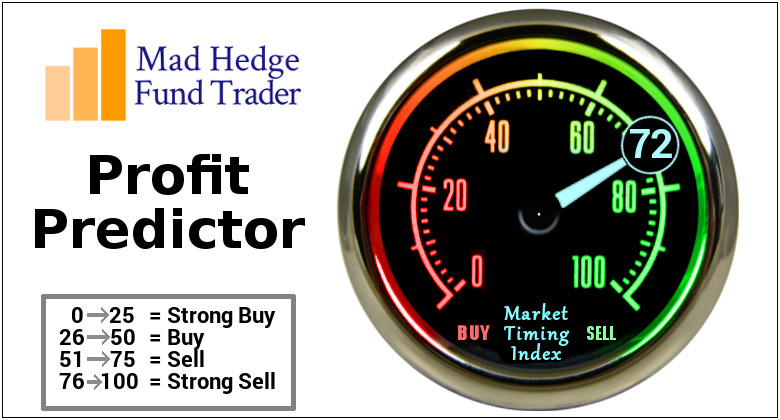
Global Market Comments
February 13, 2024
Fiat Lux
Featured Trade:
(WHAT THE ECONOMIST BIG MAC INDEX IS TELLING US NOW),
(FXF), (FXE), (FXA), (CYB)

The Swiss franc is wildly overvalued, as are the Norwegian kroner and the Uruguayan peso. On the other hand, the Venezuelan bolivar, UAE dirham, and the Brazilian real off real value.
Who has the cheapest currency in the world? The Ukrainian hryvnia, which at 25 cents to the US dollar offers the cheapest Big Mac in the world. I had one in October, and they taste just the same, but is a bargain at $5.00. That explains the proliferation of McDonald's hamburger stands in the capital city of Kiev. They are always packed.
With interest rates and inflation the urgent topics of the day, everyone has their favorite inflation indicator. The Fed has money supply growth, you have yours, and well, I have mine.
My former employer, The Economist, once the ever-tolerant editor of my flabby, disjointed, and juvenile prose (Thanks Peter and Marjorie), released its “Big Mac” index of international currency valuations in 1987.
Although initially launched as a joke, I have followed it religiously and found it an amazingly accurate predictor of future economic success. The heart attack on a plate costs $5.69 in most of the US.
The Economist index counts the cost of McDonald’s (MCD) premium sandwiches around the world, ranging from 142% the cost of an American Big Mac in Switzerland to only 84.5% in Brazil, and comes up with a measure of currency under and overvaluation.
I couldn’t agree more with many of these conclusions. It’s as if the August weekly publication was tapping The Diary of the Mad Hedge Fund Trader for ideas.
I am no longer the frequent consumer of Big Macs that I once was, as my metabolism has slowed to such an extent that in eating one, you might as well tape it directly to my middle. Better to use it as an economic forecasting tool, than a speedy lunch.
Having followed this index religiously for 37 years, I am able to make some astute long-term observations. For a start, the US dollar has been at the top of the range for most of its life. This is because the US has had the best major economic growth rate over the last four decades, averaging a real 3.0%.
Another factor is that America has also had the world’s highest large economy interest rates, thanks to a very tough inflation-fighting Federal Reserve. I doubt Jay Powell eats Big Macs. He’s too thin.
You will also find that the cheap end of the range is always populated by the same countries year in and year out. These are poorly governed, money-printing, economically chaotic countries with little regard for their currencies. Don’t cry for me Argentina and throw in Venezuela. They will always be cheap. Invest there at your peril.
And yes, making your currency calls based on the price of hamburgers has its risks. But it does give me a wonderful excuse to travel around the world taking pictures of fast-food stands.
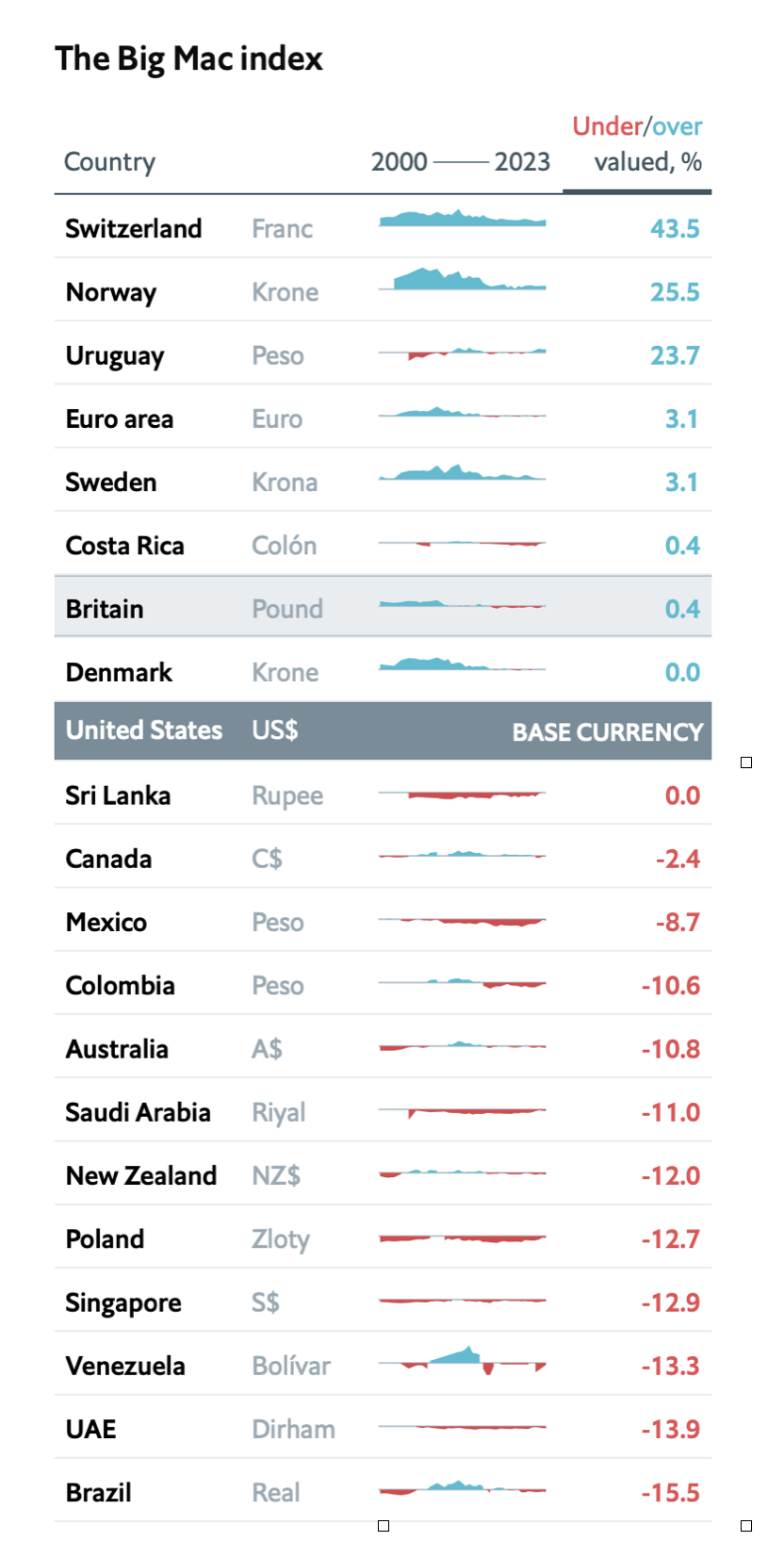
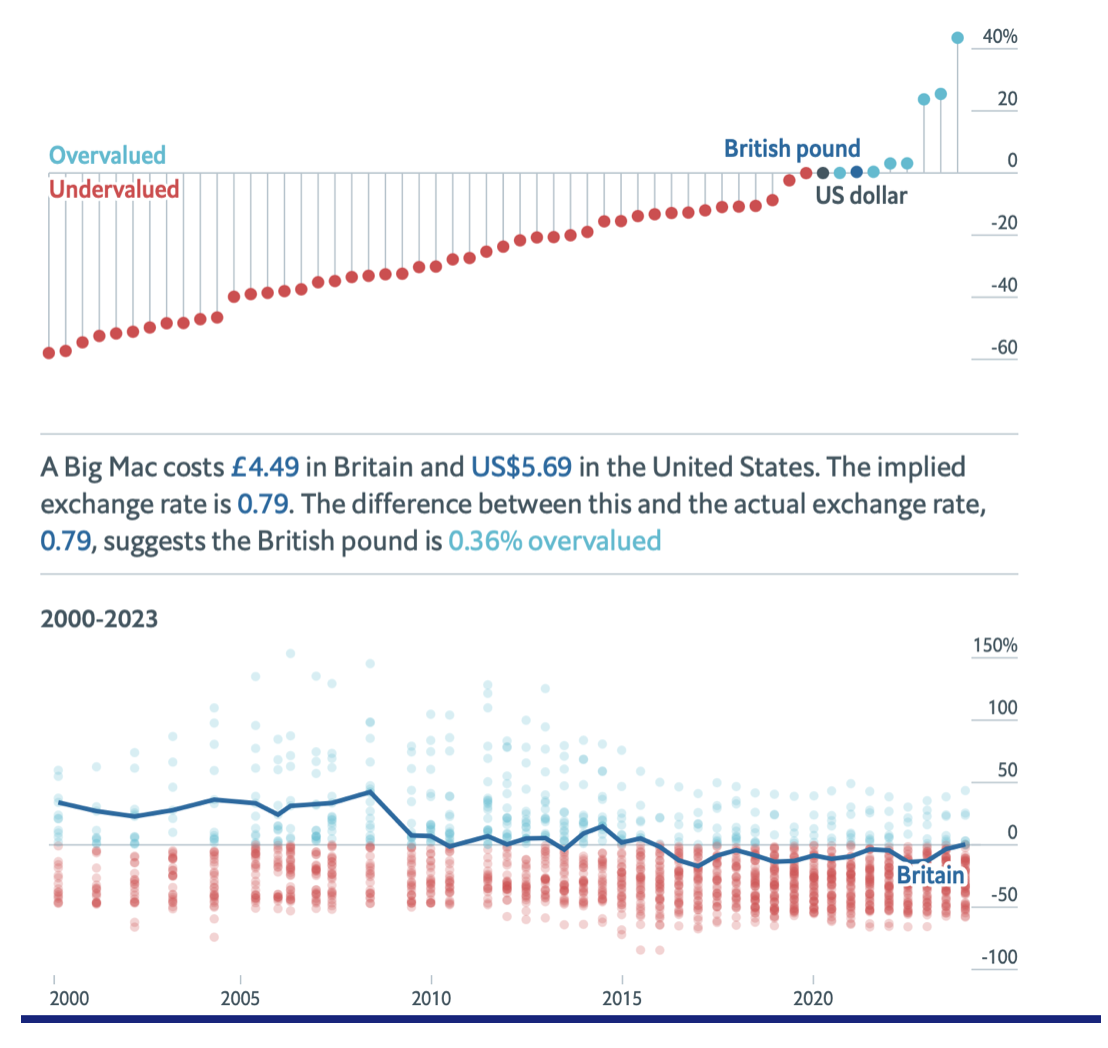
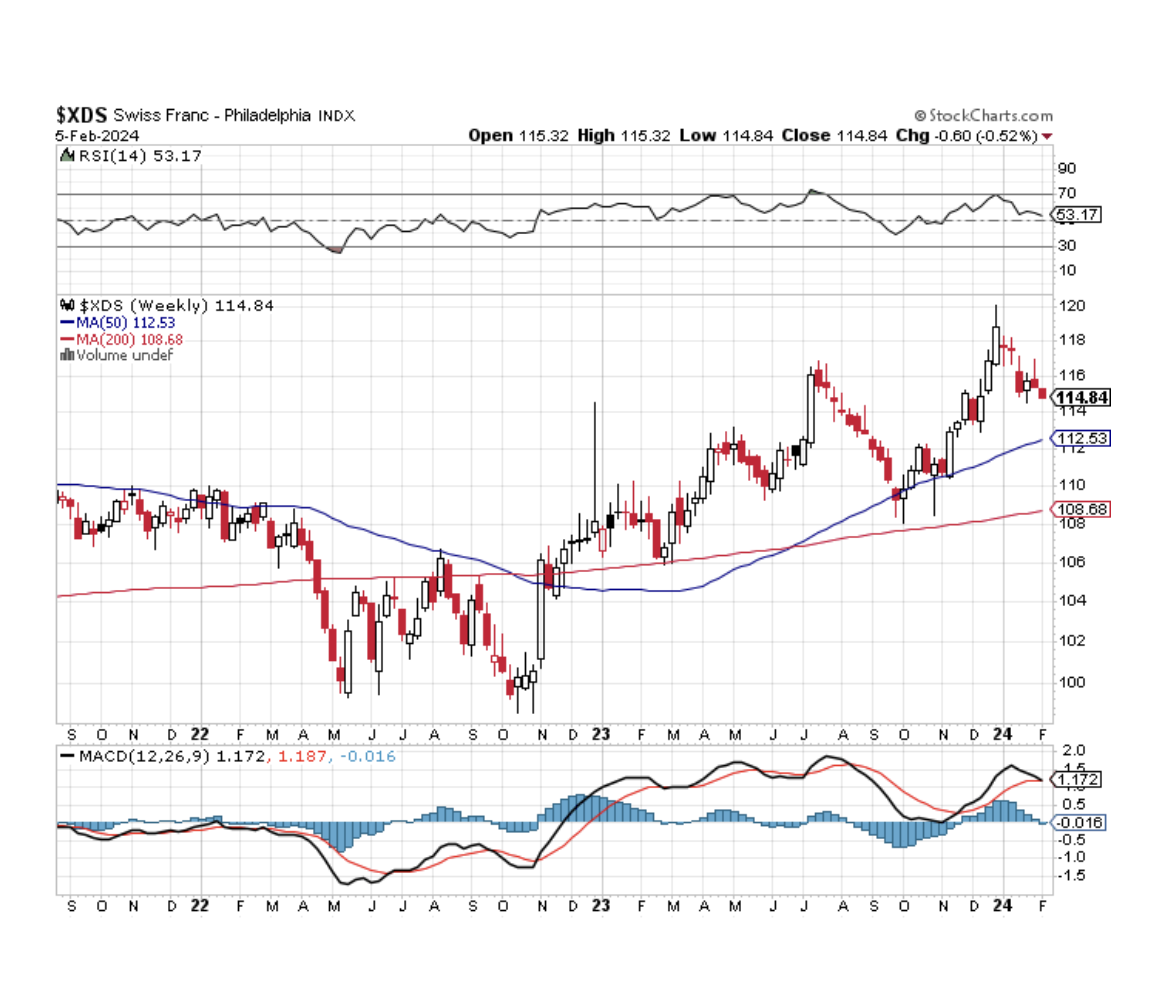
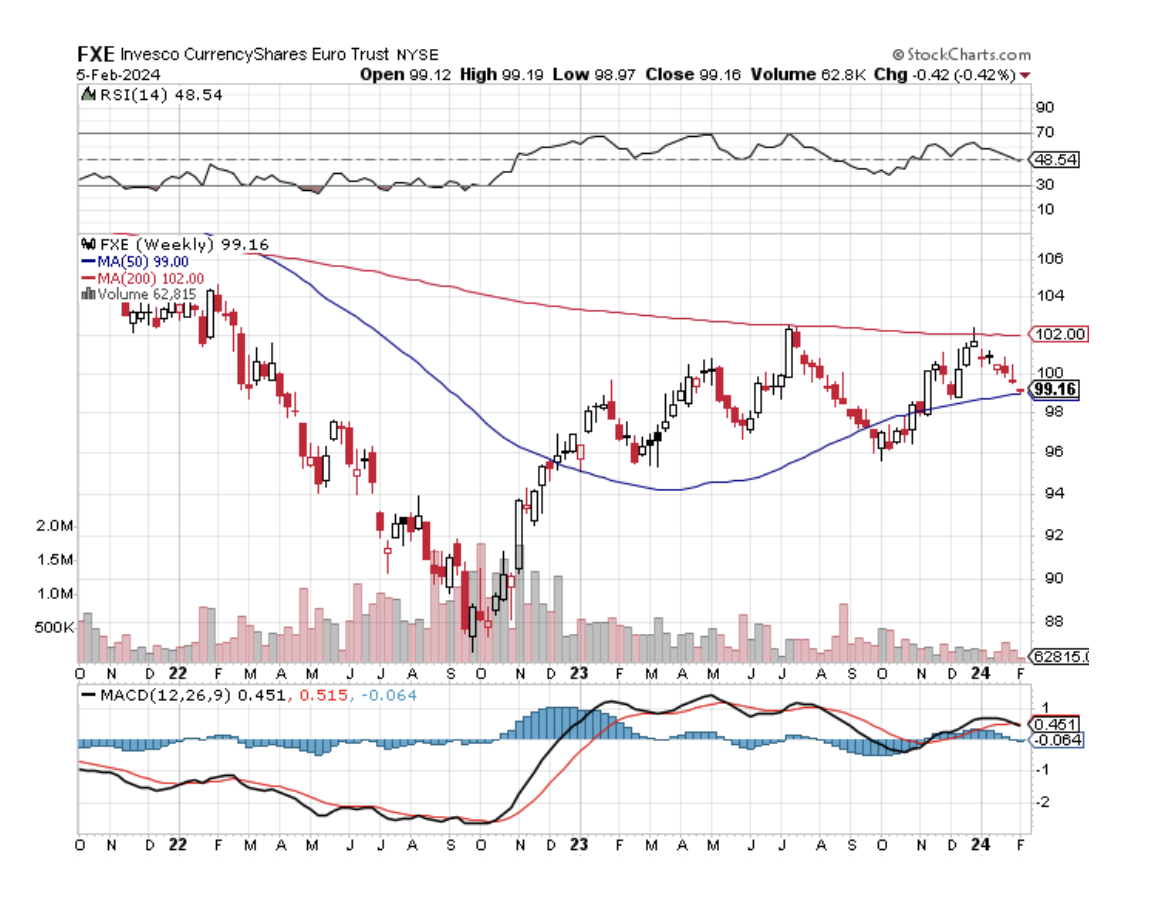

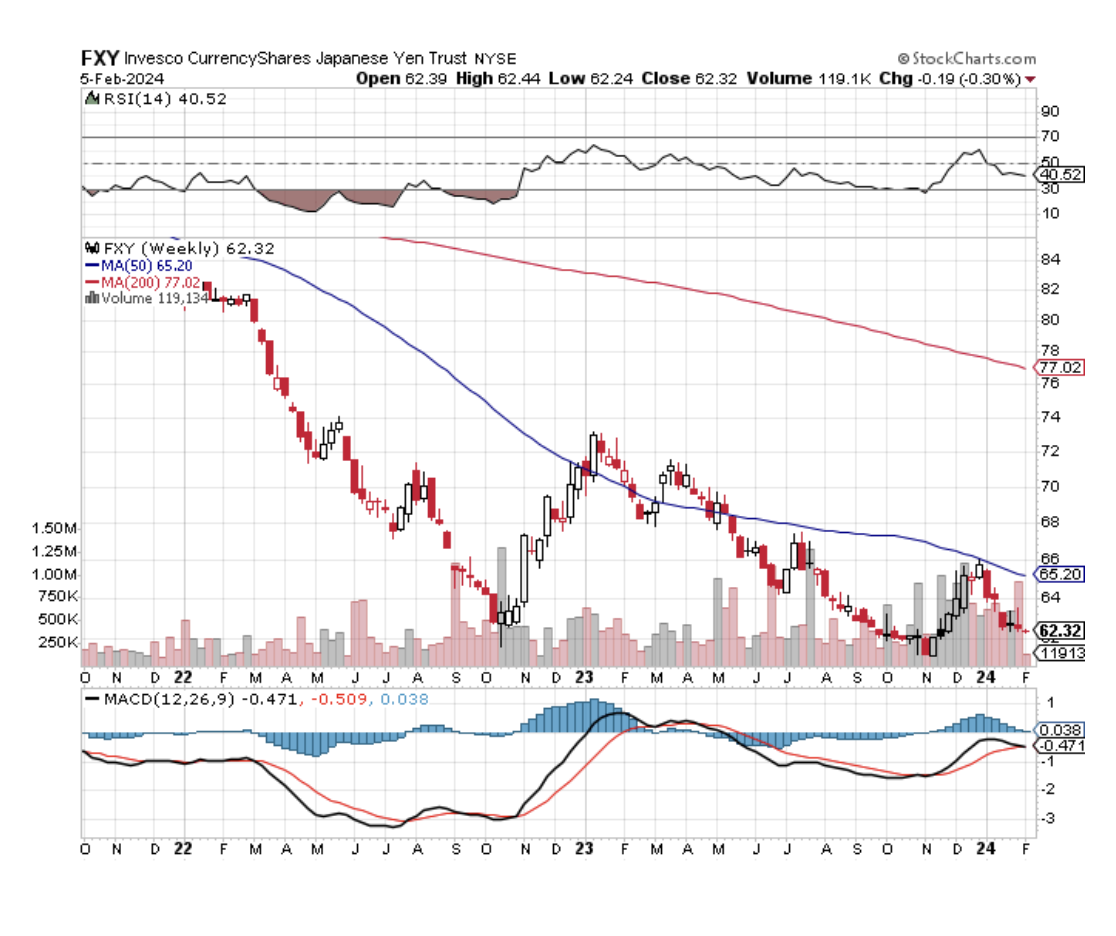

The Big Mac in Swiss francs is Definitely Not a Buy
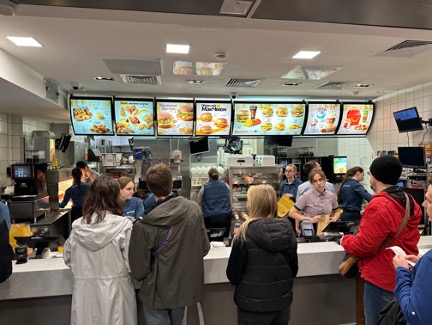
But it’s the Deal of the Century in Kiev
Global Market Comments
January 12, 2024
Fiat Lux
Featured Trade:
(JANUARY 10 BIWEEKLY STRATEGY WEBINAR Q&A)
(SPY), (UNG), (NVDA), (UUP), (FXA), (GOOG), (GOOGL), (GLD), (GOLD), (WPM), (BYDDY), (F), (GM), (TSLA)
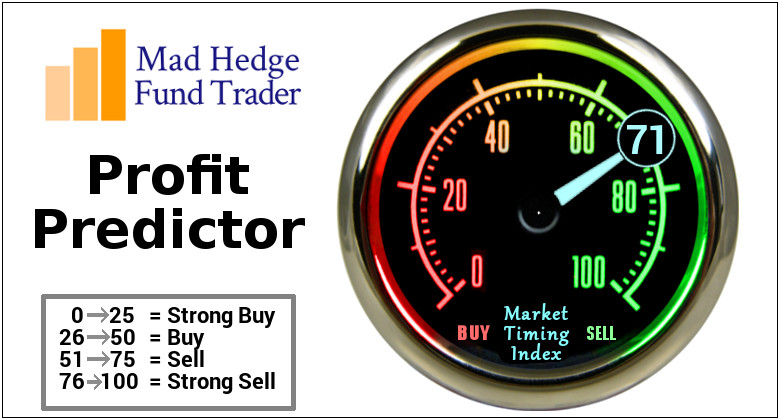
Below please find subscribers’ Q&A for the January 10 Mad Hedge Fund Trader Global Strategy Webinar, broadcast from Silicon Valley, CA.
Q: Would you sell Nvidia (NVDA) covered calls?
A: No, I would not. Nvidia could double at any time, or at least go up 50%. That is not a covered call writing situation, that is a long call situation, or at the very least a long call spread situation. Do not bet against Nvidia on pain of death—one of the seven-stop losses I had last year was a short in Nvidia.
Q: Do you recommend any brokers for executing my trades?
A: Yes, I recommend Tastytrade (click here) because I know the owner of the company, and they have the lightest code in the entire industry. It’s written to go very fast; that gives you a price advantage over other platforms. Plus they have very competitive margin rates and commissions. They only charge commissions on openings, not on closings.
Q: Why are you adding positions when the market timing index is so high? Aren't you supposed to be avoiding risk here?
A: The market timing index in the PowerPoint is for the S&P 500 only. If you look at the individual stocks that I've added in the last two days, they've all had 10-20% corrections. So you don't want to touch the main market up here. If anything it's a short, and I am looking at an S&P 500 (SPY) short, by the way, to hedge our other longs. Individual stocks have already corrected, and I've already started to add positions in the leaders for the year. Big tech is moving up; it’s leading the rally so that is what's happening there.
Q: Is it time to buy Tesla (TSLA)? It's a 200-day moving average.
A: I don't want to touch Tesla until the price war is over. Obviously, it's still continuing and Tesla itself is leading the charge on the price war, so I would hold off on that while the other tech stocks like Nvidia (NVDA) are so hot.
Q: I bought the UNG (United States Natural Gas Fund) LEAPS you put out over the Christmas vacation. They have since doubled in value in two weeks. Should I take profits?
A: Yes. Always take a profit in any option play when you get an immediate return because they have the tendency to give up those returns very quickly. They do call natural gas the “widow maker” in the commodities market because of the extreme volatility. So when you get a 50% move in natural gas or any commodity, take the money and run. Go to Las Vegas for a weekend, take your wife to Hawaii, pay off your kid's student loans, or buy yourself a new Rolex watch! Take the quick profit. You always get a chance to buy again on a dip, and there’s nothing like starting off 2024 with a double on a LEAP. For me, it's a matter of professional pride, not about the money. So way to go, John Thomas.
Q: Has crude oil reached the bottom?
A: $70 per barrel has been holding for a long time, but it's not acting like a bottom. I have to tell you, it's not getting any big dead cat bounces you see at real bottoms. So my guess is we have to move into the 60s, maybe all the way down to $62 before we get a turnaround. We need to see a turnaround in the global economy before we get a turnaround in the price of oil, and especially a turnaround in China, which is the world's largest importer of oil—and there is no sign of that happening anytime soon. So there is your answer; watch China.
Q: Will any Bitcoin ETFs be approved in the US?
A: Probably yes, but that also could mark a top of the market. Remember the insiders, the miners, have a huge trading advantage over us. Which is one reason why I'm avoiding this asset class this time around. I have a feeling we'll peak lower than the last high, and then we go back down into lows again. So avoid Bitcoin. There are too many other better things to buy now like Nvidia. During the last Bitcoin peak, all the techs were insanely expensive, and now they're not. We have better alternatives to crypto than we did two years ago.
Q: With China not improving, do you still like the US dollar to drop and the Australian dollar to increase?
A: I do expect the US dollar (UUP) to fall. I think it's peaked out and already dropped 10%, and I expect the Aussie (FXA) to rise. It's already risen by about 7%, but not because of China. It's happening because the US will cut interest rates anywhere from 3 to 6 times this year. And it could be either; it could be 3 quarter-point rate cuts, or it could be 6. I'm kind of leaning towards 6 myself. Which leads to the next question...
Q: Do you still like bonds?
A: Absolutely, yes. (TLT) is trading around $97 today. I'm looking for it to hit $110 to $120 by the end of the year, plus the interest payments. So the total return on (TLT) bonds will be between 18% and 28% on the year. Most people will take that.
Q: Do you still like uranium?
A: Yes. In fact, just last week, France announced it was building 14 new nuclear power plants. These are the big 1 to 4-megawatt old-style plants on top of their additional programs. So that creates more demand for yellow cake fuel and more demand for uranium, and it is getting a lot of push these days as a green fuel. Which it is—it is non-carbon producing. By the way, look at NuScale (SMR) if you're interested in uranium because they have the newest design that solves all the old nuclear problems. And the stock just had a big selloff because they lost a customer.
Q: Do you still like the banks?
A: Well, all four of the financial LEAPS that I recommended at the bottom of the banking crisis in March are all expiring this month at max profits anywhere over a hundred percent. So yes, I love the banks, but I don't especially like them right here, not on top of 30-35% gains. So wait for a pullback. These would be great candidates for any sell-off going into March; that's when we take another look at these. Oh, and if another bank goes bankrupt so much the better, that creates much better entry points.
Q: What's the best way to trade long-term dollar shorts (UUP)?
A: The answer is through futures contracts through banks, is the cheapest way to do it. You get a leverage of 10 to 100 times depending on the contract. You can do long or short. The dealing expenses are the cheapest, and that's how professionals trade for their own account, is through futures contracts through banks. It's not really an equity play. There are a number of short-dollar ETFs out there, but dealing with expenses wide, tracking errors is big so it is not an efficient way to do it. So, that would be my recommendation on long-term dollar shorts. The other way is to buy the Australian dollar, the (FXA).
Q: How are your stem cell knee injections working, John?
A: Fantastic. It completely cured my arthritis with my stem cell injections in my knees and lower back. And after I got shot in the hip in Ukraine, I had a Stem cell injection there too, and that worked. So the pain is completely gone from that bullet wound I got from the Russians in October. Yes, I'm one of the lucky people where everything stem cell-related seems to work, so I do all of them. Go ahead and try it, it’ll only cost you a thousand dollars or two per injection.
Q: When trading Google, do you use the (GOOGL) or just the (GOOG)?
A: One is the holding company, and one is the operating company for the search business. It's really six of one and half a dozen of the other. Both are liquid. The tracking between the two is almost nil, so I don't bother.
Q: Do you expect a recession or high unemployment this year?
A: No, you never get recessions or high unemployment in election years. And much of the spending that the administration obtained years ago has yet to be spent. You know, the lag time on government spending is in the years and it magically tends to happen the most in election years. Go figure. So after a slowdown in the first quarter, I'm expecting to speed up going into the rest of the year.
Q: How much can gold (GLD) go up this year?
A: At least 20 to 30%. Which means the Barrick Gold (GOLD) and Newmont Mining (NEM) could easily double this year. And what about silver? It should go up even more. Which means a Wheaton Precious Metals (WPM) leap at this level should go up 400%. Yes, you've heard it here first, 400% with fairly low risk. And if you want to know how to do that, just search for LEAPS on my website or become a concierge member and you can call me and I'll tell you how to do it. I'll guide your hand on how to do the trade.
Q: Is BYD in China a threat to Tesla (TSLA)?
A: No. BYD Motors (BYDDY) is taking over the low end of the market. Read the least profitable end of the market in China where they actually sell more cars than Tesla including hybrids, but Tesla still leads in EVs, and it's the question of would you rather own a Rolls Royce or a Volkswagen. That is the choice. In China, people buy EVs to show off their wealth, and a BYD car shows off your humility or at least your stinginess. So in some emerging markets where cost is the issue, BYD may take over the market, but they won't make very much money at it. And in other markets where quality is the issue like the US, like China, Tesla will dominate and you may end up with a situation like you have with Apple (APPL). Apple has only a 6% market share in the global cell phone business, but they account for 91% of global profits in the cell phone business, and Tesla could do the same. They could end up making all the money with a lesser market share ceding the bottom end or the money-losing end of the market to BYD, Ford (F), General Motors (GM), or anybody else down there.
Q: What do you think of a (TLT) February $90-$93 vertical bull call debit spread for February?
A: I like it. It’s a little close to the money—I usually try to go out $5 points on the TLT strikes when I'm setting these up. So that's a little aggressive, but you'll end up making more money. My bet is you could make 20% on this call spread right here. So many people are still trying to get into the bond market. They got left out, the move up was so fast since October. The institutional investors that dominate that market are not used to the idea of speed. So yes, I think we're looking at a sideways move before the next leg up.
To watch a replay of this webinar with all the charts, bells, whistles, and classic rock music, just log in to www.madhedgefundtrader.com, go to MY ACCOUNT, click on GLOBAL TRADING DISPATCH, TECHNOLOGY LETTER, or JACQUIE'S POST, then WEBINARS, and all the webinars from the last 12 years are there in all their glory.
Good Luck and Stay Healthy,
John Thomas
CEO & Publisher
The Diary of a Mad Hedge Fund Trader
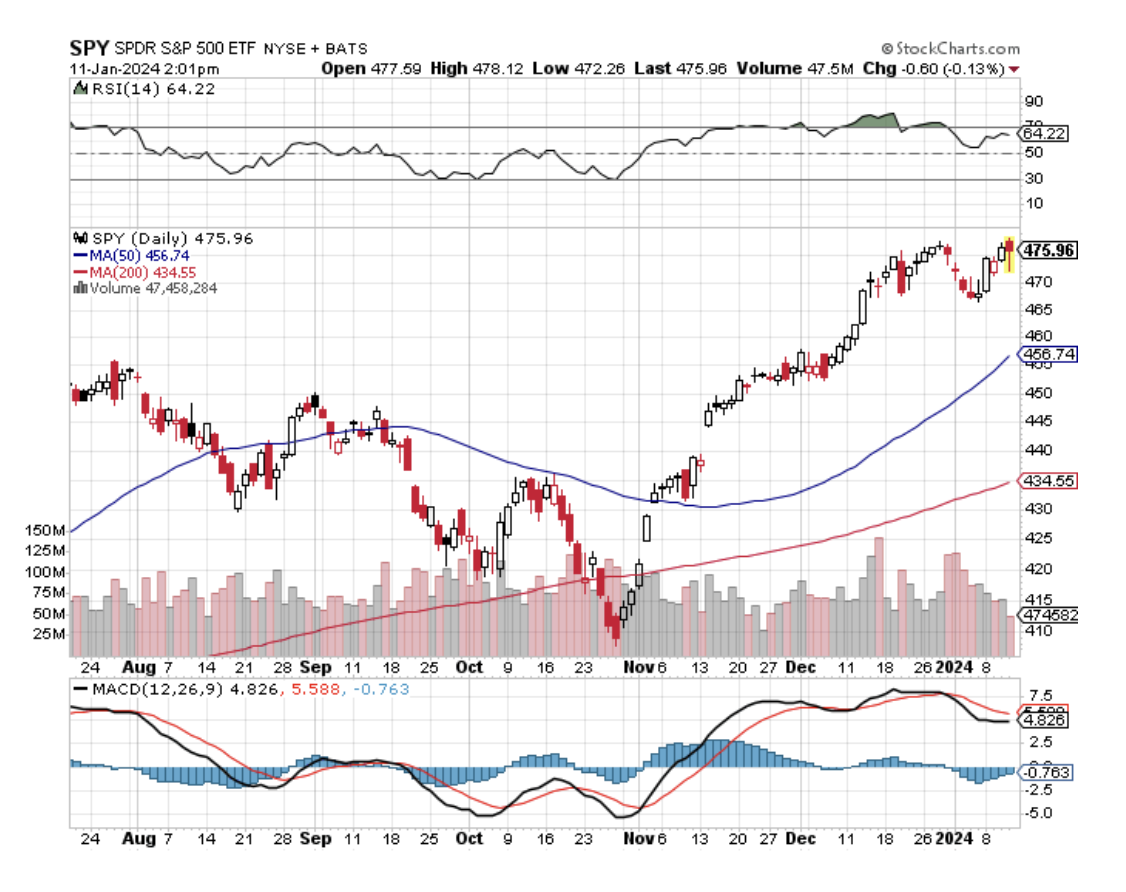

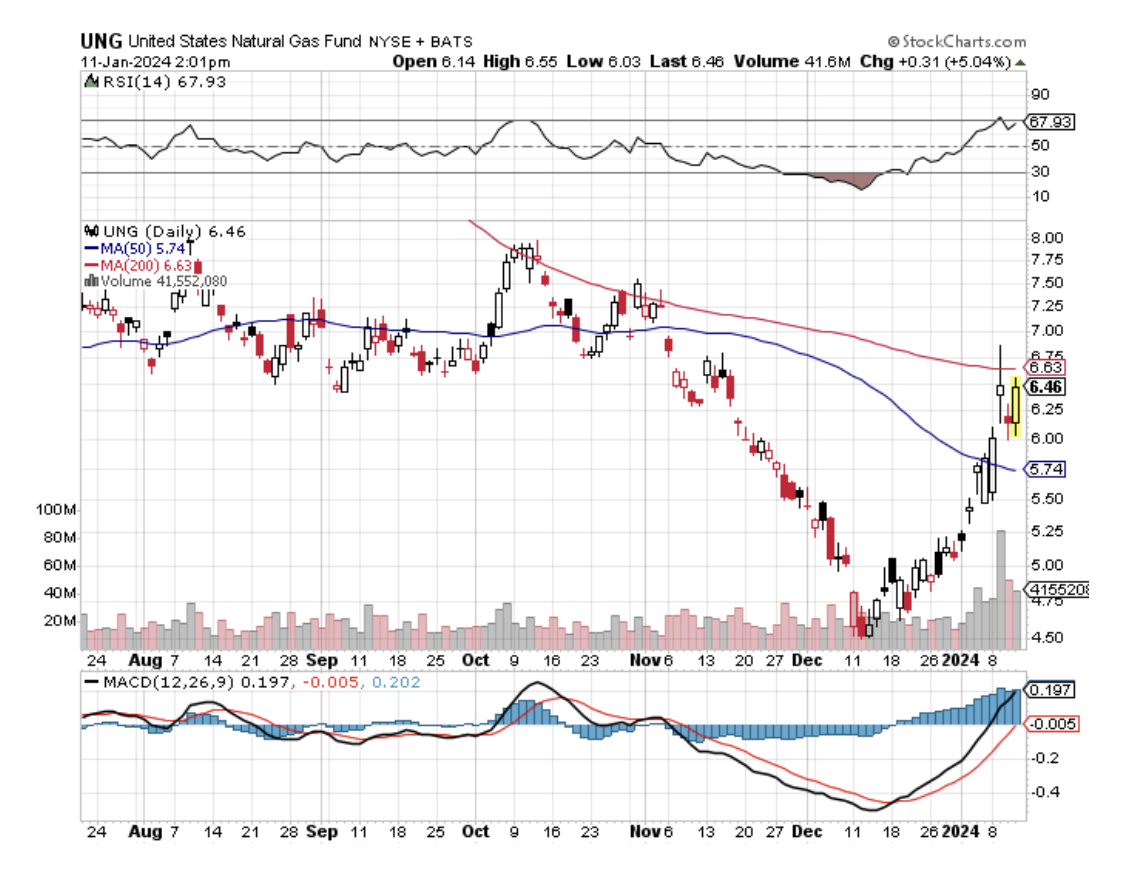

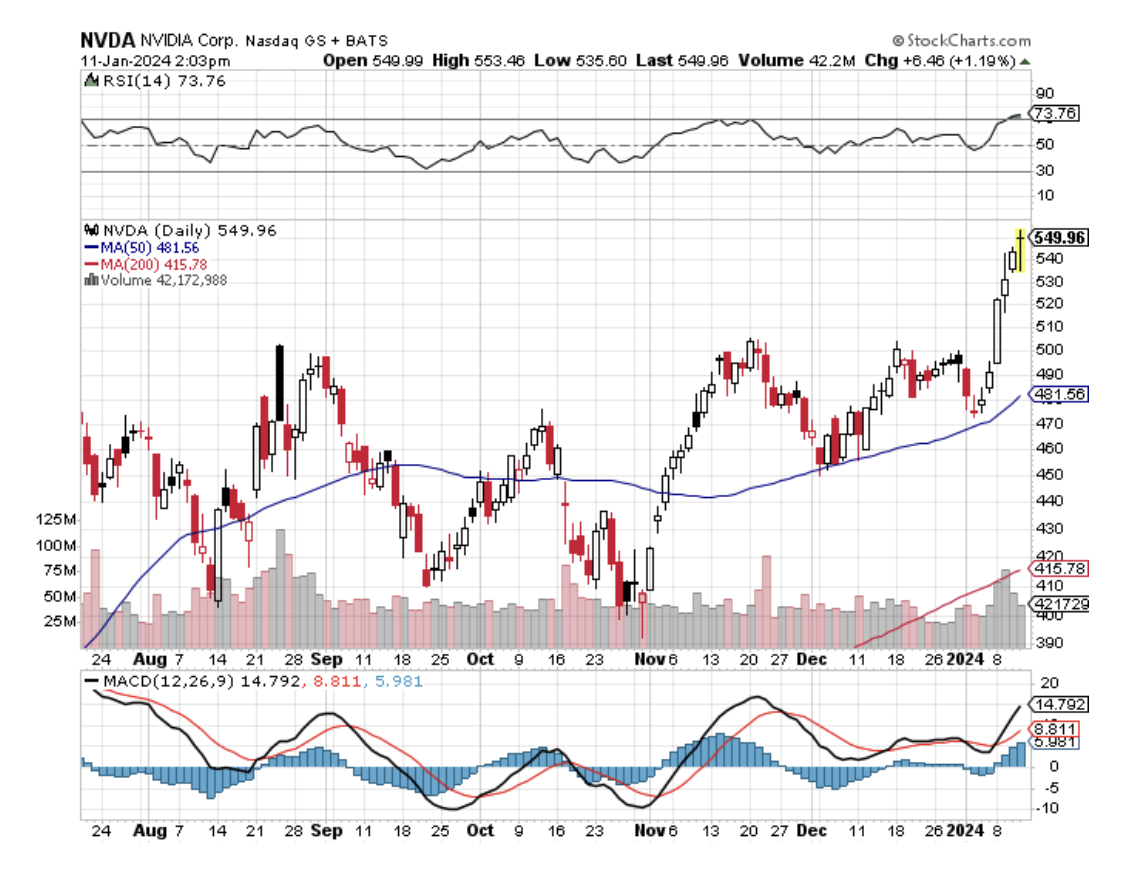
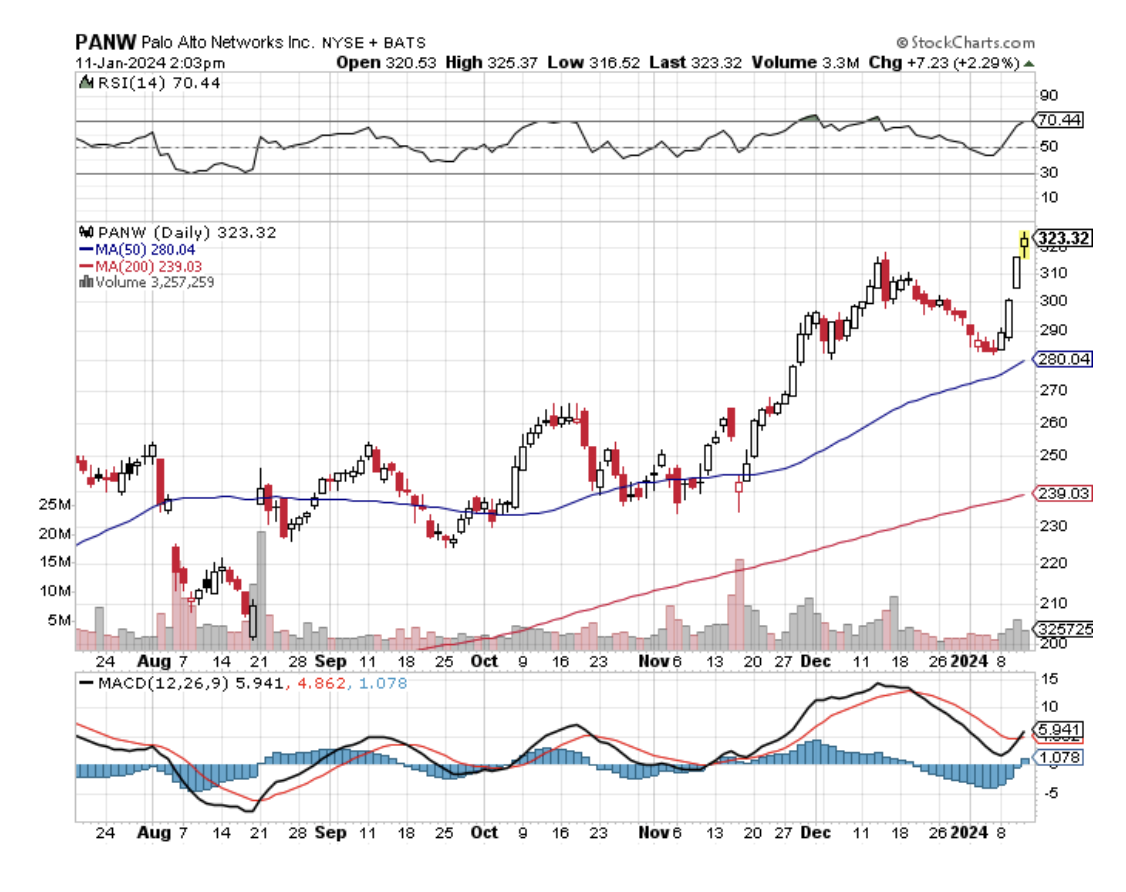

Any trader will tell you the trend is your friend, and the overwhelming direction for the US dollar (UUP) for the last 242 years has been down.
Our first Treasury Secretary, Alexander Hamilton, found himself constantly embroiled in sex scandals. Take a ten-dollar bill out of your wallet and you’re looking at a world-class horn dog, a swordsman of the first order.
When he wasn’t fighting scandalous accusations in the press and the courts, he spent much of his six years in office orchestrating a rescue of our new currency, the US dollar.
Winning the Revolutionary War bankrupted the young United States, draining it of resources and leaving it with huge debts.
Hamilton settled many of these by giving creditors notes exchangeable for then-worthless Indian land west of the Appalachians.
As soon as the ink was dry on these promissory notes, they traded in the secondary market for as low as 25% of face value, beginning a centuries-long government tradition of stiffing its lenders, a practice that continues to this day.
My unfortunate ancestors took him up on his offer, the end result being that I am now writing this letter to you from California—and am part Cherokee, Delaware, and Sioux.
It all ended in tears for Hamilton, who, misjudging former Vice President Aaron Burr’s true intentions in a New Jersey duel, ended up with a bullet in his back that severed his spinal cord.
Since Bloomberg machines weren’t around in 1782, we have to rely on alternative valuation measures for the dollar then, like purchasing power parity, and the value of goods priced in gold.
A chart of this data shows an undeniable permanent downtrend, which greatly accelerated after 1933 when FDR banned private ownership of gold and devalued the dollar.
Today, going short the currency of the world’s largest borrower, running the greatest trade and current account deficits in history, with a diminishing long-term growth rate is a no-brainer.
But once it became every hedge fund trader’s free lunch, and positions became so lopsided against the buck, a reversal was inevitable.
We seem to be solidly in one of those periodic corrections, which began a few years ago and could continue for months, or even years more.
The euro has its own particular problems, with the cost of a generous social safety net sending EC budget deficits careening. Add to that the gargantuan cost of a burgeoning refugee crisis.
Use this strength in the greenback to scale into core long positions in the currencies of countries that are major commodity exporters, boast rising trade and current account surpluses, and possess small consuming populations.
I’m talking about the Canadian dollar (FXC), the Australian dollar (FXA), and the New Zealand dollar (BNZ), all of which will eventually hit parity with the greenback once again.
Think of these as emerging markets where they speak English, best played through the local currencies.
For a sleeper, buy the Chinese Yuan ETF (CYB) for your backbook. A major revaluation by the Middle Kingdom is just a matter of time as long as the economy is growing at 6% a year or more.
I’m sure that if Alexander Hamilton were alive today, he would counsel our modern Treasury Secretary, Steven Mnuchin, to talk the dollar up, but to do everything he could to undermine the buck behind the scenes, thus over time depreciating our national debt down to nothing through a stealth devaluation.
Given Mnuchin’s performance so far regarding the dollar, I’d say he studied his history well.
Hamilton must be smiling from the grave.
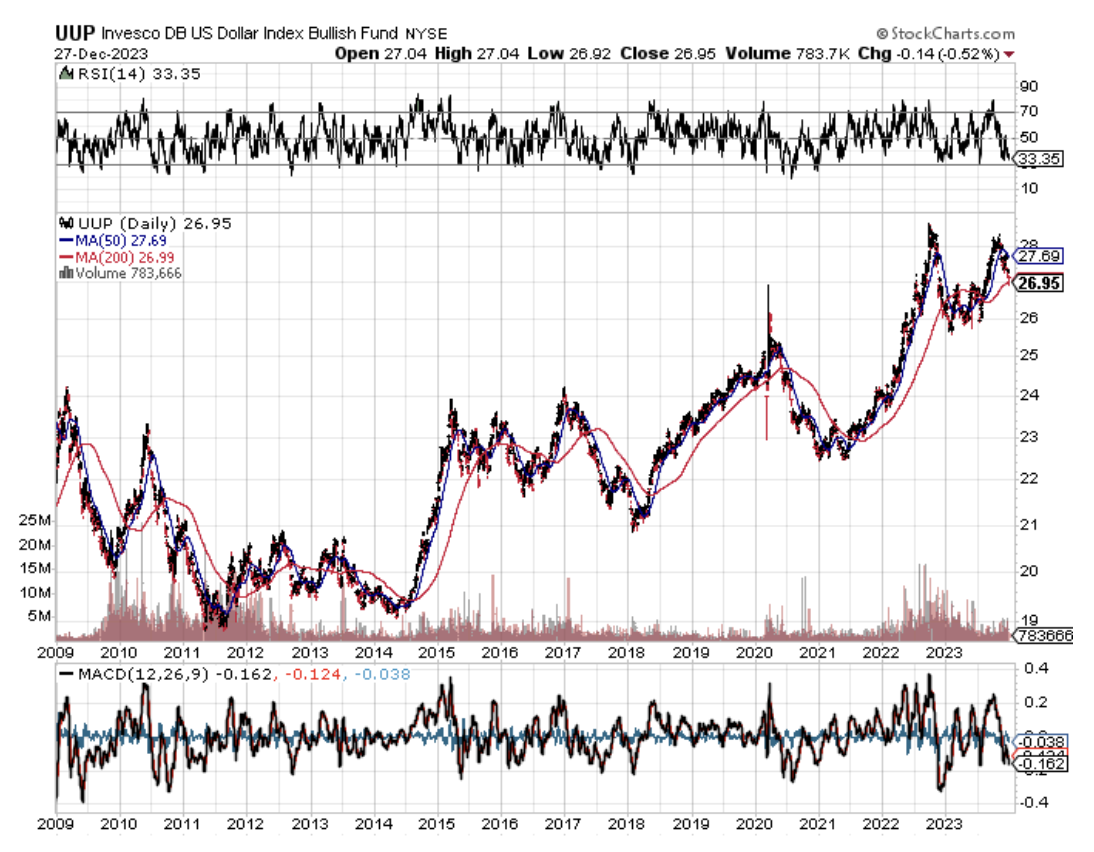
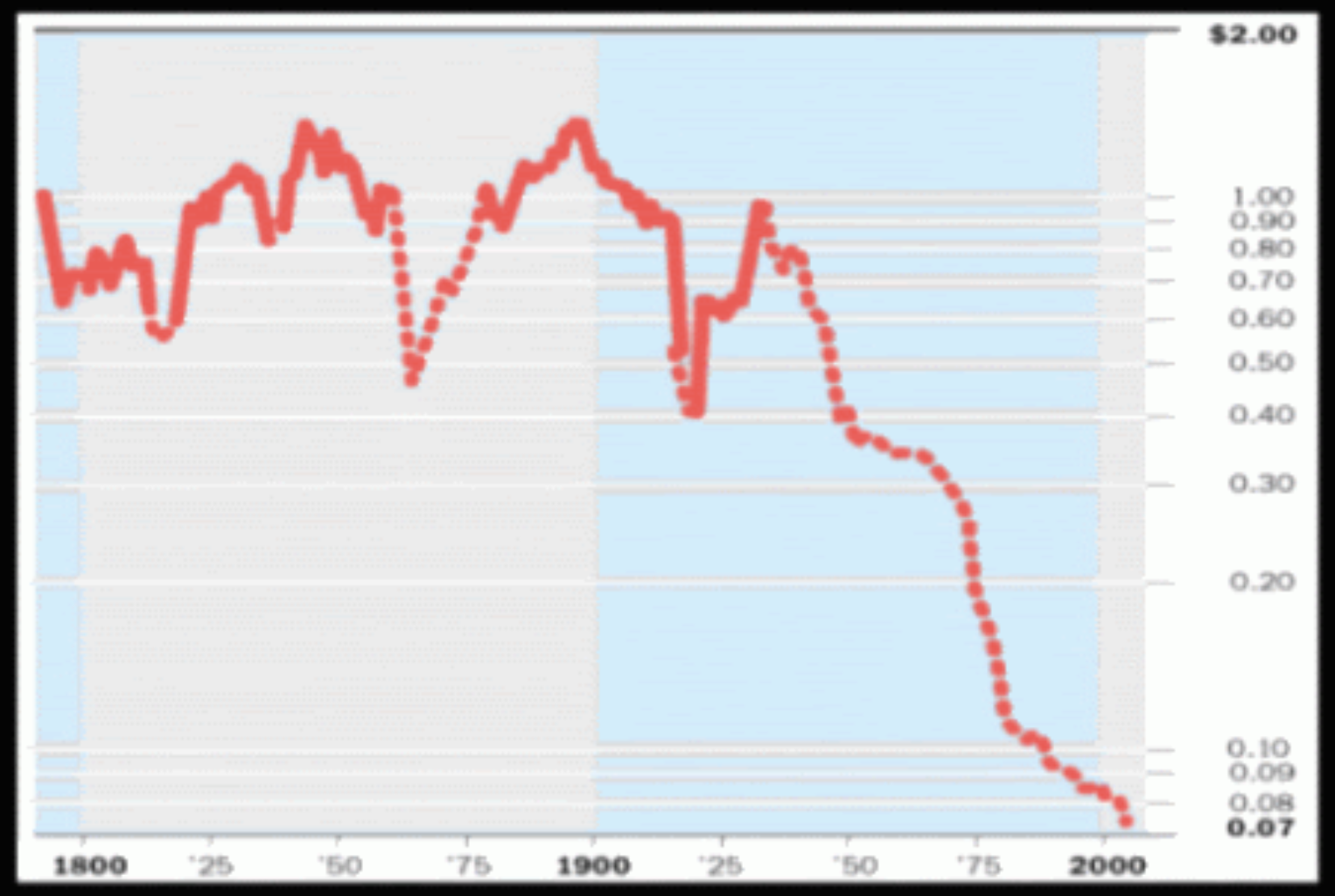
A 242-Year Chart of the US Dollar priced in Hard Goods
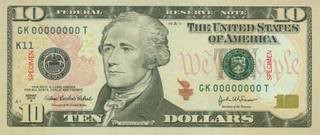
Global Market Comments
January 3, 2024
Fiat Lux
2024 Annual Asset Class Review
A Global Vision
FOR PAID SUBSCRIBERS ONLY
Featured Trades:
(SPX), (QQQ), (IWM) (AAPL), (XLF), (BAC) (JPM), (BAC), (C), (MS), (GS),
(X), (CAT), (DE),(TLT), (TBT), (JNK), (PHB), (HYG), (MUB), (LQD), (FXE), (EUO),
(FXC), (FXA), (YCS), (FXY), (CYB), (DIG), (RIG), (USO), (DUG), (UNG), (USO),
(XLE), (AMLP),(GLD), (DGP), (SLV), (PPTL), (PALL), (ITB), (LEN), (KBH), (PHM)
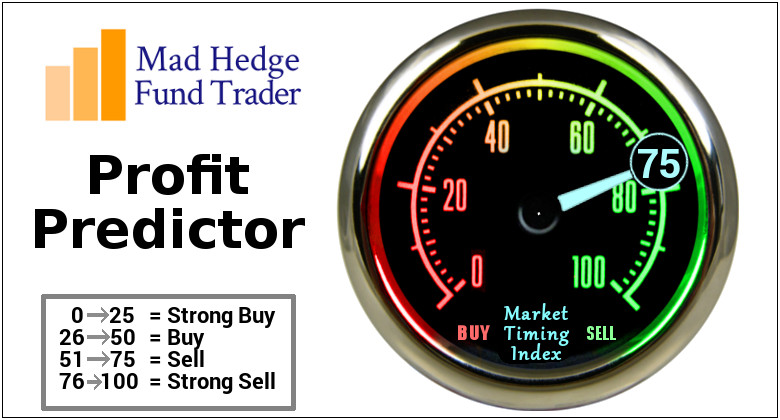
I am once again writing this report from a first-class sleeping cabin on Amtrak’s legendary California Zephyr.
By day, I have a comfortable seat next to a panoramic window. At night, they fold into two bunk beds, a single and a double. There is a shower, but only Houdini can navigate it.
I am anything but Houdini, so I foray downstairs to use the larger public hot showers. They are divine.

We are now pulling away from Chicago’s Union Station, leaving its hurried commuters, buskers, panhandlers, and majestic great halls behind. I love this building as a monument to American exceptionalism.
I am headed for Emeryville, California, just across the bay from San Francisco, some 2,121.6 miles away. That gives me only 56 hours to complete this report.
I tip my porter, Raymond, $100 in advance to ensure everything goes well during the long adventure and keep me up to date with the onboard gossip.
The rolling and pitching of the car is causing my fingers to dance all over the keyboard. Microsoft’s Spellchecker can catch most of the mistakes, but not all of them.

Chicago’s Union Station
As both broadband and cell phone coverage are unavailable along most of the route, I have to rely on frenzied Internet searches during stops at major stations along the way, like Omaha, Salt Lake City, and Reno, to Google obscure data points and download the latest charts.
You know those cool maps in the Verizon stores that show the vast coverage of their cell phone networks? They are complete BS.
Who knew that 95% of America is off the grid? That explains so much about our country today.
I have posted many of my better photos from the trip below, although there is only so much you can do from a moving train and an iPhone 15 Pro.
Here is the bottom line which I have been warning you about for months. In 2024 we will probably top the 70.44% we made last year, but you are going to have to navigate the reefs, shoals, hurricanes, and the odd banking crisis. Do it and you can laugh all the way to the bank. I will be there to assist you in navigating every step.
The first half of 2024 will be all about trading, making bets on when the Fed starts cutting interest rates. Technology will continue their meteoric melt-up. In the second half, I expect the cuts to actually take place and markets to go straight up. Domestic industrials, commodities, financials, energy foreign markets, and currencies will lead.
And here is my fundamental thesis for 2024. After the Fed kept rates too low for too long and then raised them too much, it will then panic and lower them again too fast to avoid a recession. In other words, a mistake-prone Jay Powell will keep making mistakes. That sounds like a good bet to me.
Keep in mind that the Mad Hedge AI Market Timing Index is at the absolute top end of its historic range the three-month likelihood of you making money on a trade is essentially zero. But adhere to the recommendations I make in this report today and you should be up about 30% in a year.
Let me give you a list of the challenges I see financial markets facing in the coming year:

The Ten Key Variables for 2024
1) When will the Fed pivot?
2) When will quantitative tightening end?
3) How soon will the Russians give up on Ukraine?
4) When will the rotation from technology to domestic value plays happen?
5)How much of falling interest rates will translate into higher gold prices?
6) When will the structural commodities boom get a second wind?
7) How fast will the US dollar fall?
8) How quickly will lower interest rates feed into a hotter real estate market?
9) How fast can the Chinese economy bounce back from Covid-19?
10) When does the next bull market in energy begin?
All the answers are below:


Somewhere in Iowa
The Thumbnail Portfolio
Equities – buy dips
Bonds – buy dips
Foreign Currencies – buy dips
Commodities – buy dips
Precious Metals – buy dips
Energy – buy dips
Real Estate – buy dips

1) The Economy – From Hot to Cool to Hot Again
2023 was a terrible year for economists who largely got it wrong. Many will be driving Uber cabs from January.
The economy is clearly slowing now from the red-hot 5.2% GDP growth rate we saw in Q3 to a much more modest 2.0% rate in Q4. We’ll get the first read on the end of January.
Any more than that and the Fed will panic and bring interest rate cuts dramatically forward to head off a recession. That is clearly what technology stocks were discounting with a melt-up of Biblical proportions, some 19% in the last two months, or $65 in the (QQQ)’s.
Anywhere you look, the data is softening, save for employment, which is holding up incredibly well at a 3.7% headline Unemployment Rate. The labor shortage may be the result of more workers dying from COVID-19 than we understand. Far more are working from home not showing up in the data. And many young people have just disappeared off the grid (they’re in the vans you see on the freeways).
The big picture view of what’s going on here is that after 15 years of turmoil caused by the 2008 financial crisis, pandemic, ultra-low interest rates, and excessive stimulus, we may finally be returning to normal. That means long-term average growth and inflation rates of 3.0% each.
I can’t wait.
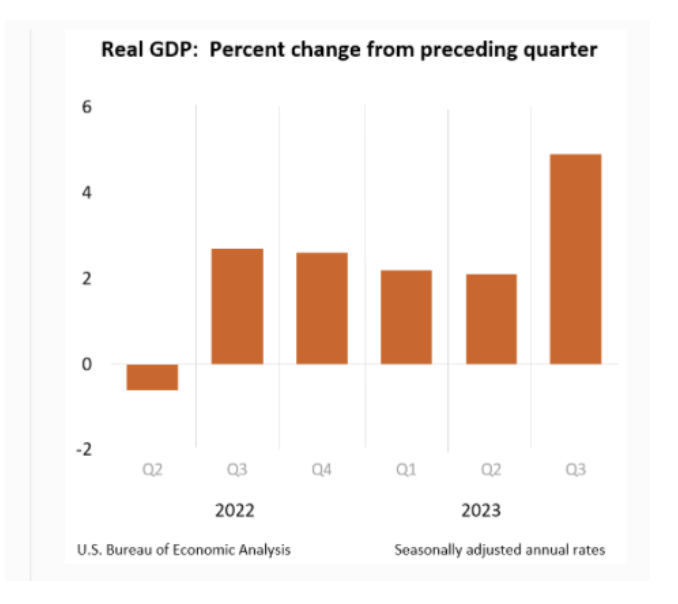

2) Equities (SPX), (QQQ), (IWM) (AAPL), (XLF), (BAC) (JPM), (C), (MS), (GS), (X), (CAT), (DE)
As I travel around the world speaking with investors, I notice that they all have one thing in common. They underestimate the impact of technology, the rate at which it is accelerating, its deflationary impact on the economy, and the positive influence they have on all stocks, not just tech ones. And the farther I get away from Silicon Valley the poorer the understanding.
Since my job is to make your life incredibly easy, I am going to simplify my equity strategy for 2024.
It's all about falling interest rates.
You should pay attention. In my January 4, 2023 Annual Asset Class Review (click here), I predicted the S&P 500 would hit $4,800 by year-end end. Here we are at $4,752.
I didn’t nail the market move because I am omniscient, possess a crystal ball, or know a secret Yaqui Indian chant. I have spent the last 30 years living in Silicon Valley and have a front-row seat to the hyper-accelerating technology here.
Since the time of the Roman Empire advancing technology has been highly deflationary (can I get you a deal on a chariot!). Now is no different, which meant that the Federal Reserve would have to stop raising interest rates in the first half of the year.
The predictions of a decade-long battle with rising prices like we saw in the seventies and eighties proved so much bunk, alarmism, and clickbait. In fact, the last 25 basis point rate rise took place on July 26, taking up from an overnight rate of 5.25% to 5.5%. That rendered the hard landing forecasts for the economy nonsense.
When interest rates are as high as they are now, you only look at trades and investments that can benefit from falling interest rates. All stocks actually benefit from cheaper money, but some much more than others.
In the first half, that will be technology plays like Apple (AAPL), (Microsoft (MSFT), Amazon (AMZN), Alphabet (GOOGL), Meta (META), and NVIDIA (NVDA). Much of this move was pulled forward into the end of 2023 so this sector may flatline for a while.
In the second half, value plays will take the leadership like banks, (JPM), (BAC), (C), financials (MS), (GS), homebuilders (KBH), (LEN), (PHM), industrials (X), capital goods (CAT), (DE), and commodities (FCX). Everything is going to new all-time highs. My Dow average of 120,000 by the end of the decade is only one more triple away and is now looking very conservative.
That means we now have at hand a generational opportunity to get into the fastest-growing sectors of the US economy at bargain prices. I’m talking Cadillacs at KIA prices. Corporate profits powered by accelerating technology, artificial intelligence, and capital spending will rise by large multiples. Every contemporary earnings forecast will come up short and have to be upgraded. 2024 will be a year of never-ending upgrades.
After crossing a long, hot desert small-cap stocks can finally see water. That’s because they are the most leveraged, undercapitalized, and at the mercy of interest rates and the economic cycle. They always deliver the most heart-rending declines going into recessions. Guess what happens now with the economy headed for a soft landing? They lead to the upside, with some forecasts for the Russell 2000 going as high as a ballistic 50%.
Another category of its own, Biotech & Health Care which is now despised, should do well on its own as technology and breakthroughs are bringing new discoveries. Artificial intelligence is discovering new drugs at an incredible pace and then telling you how to cheaply manufacture them. My top three picks there are Eli Lily (ELI), Abbvie (ABBV), and Merck (MRK).
There is another equity subclass that we haven’t visited in about a decade, and that would be emerging markets (EEM). After ten years of punishment from a strong dollar, (EEM) has been forgotten as an investment allocation. We are now in a position where the (EEM) is likely to outperform US markets in 2024, and perhaps for the rest of the decade. The drivers here are falling interest rates, a cheaper dollar, a reigniting global economy, and a new commodity boom.
Block out time on your calendars, because whenever the Volatility Index (VIX) tops $20, up from the current $12, I am going pedal to the metal, and full firewall forward (a pilot term), and your inboxes will be flooded with new trade alerts.
What is my yearend prediction for the S&P 500 for 2024. We should reach $5,500, a gain of 14.58%. You heard it here first.

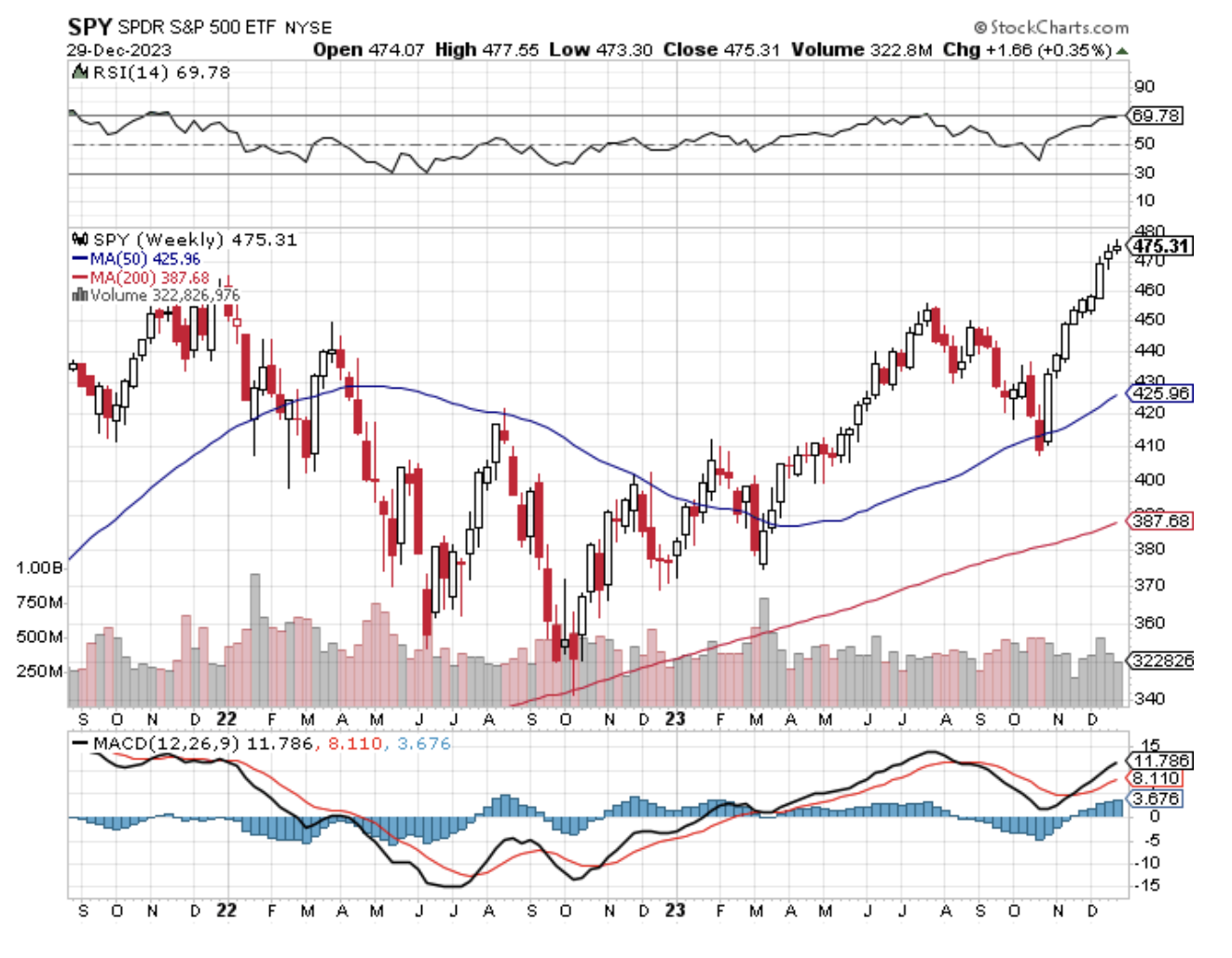
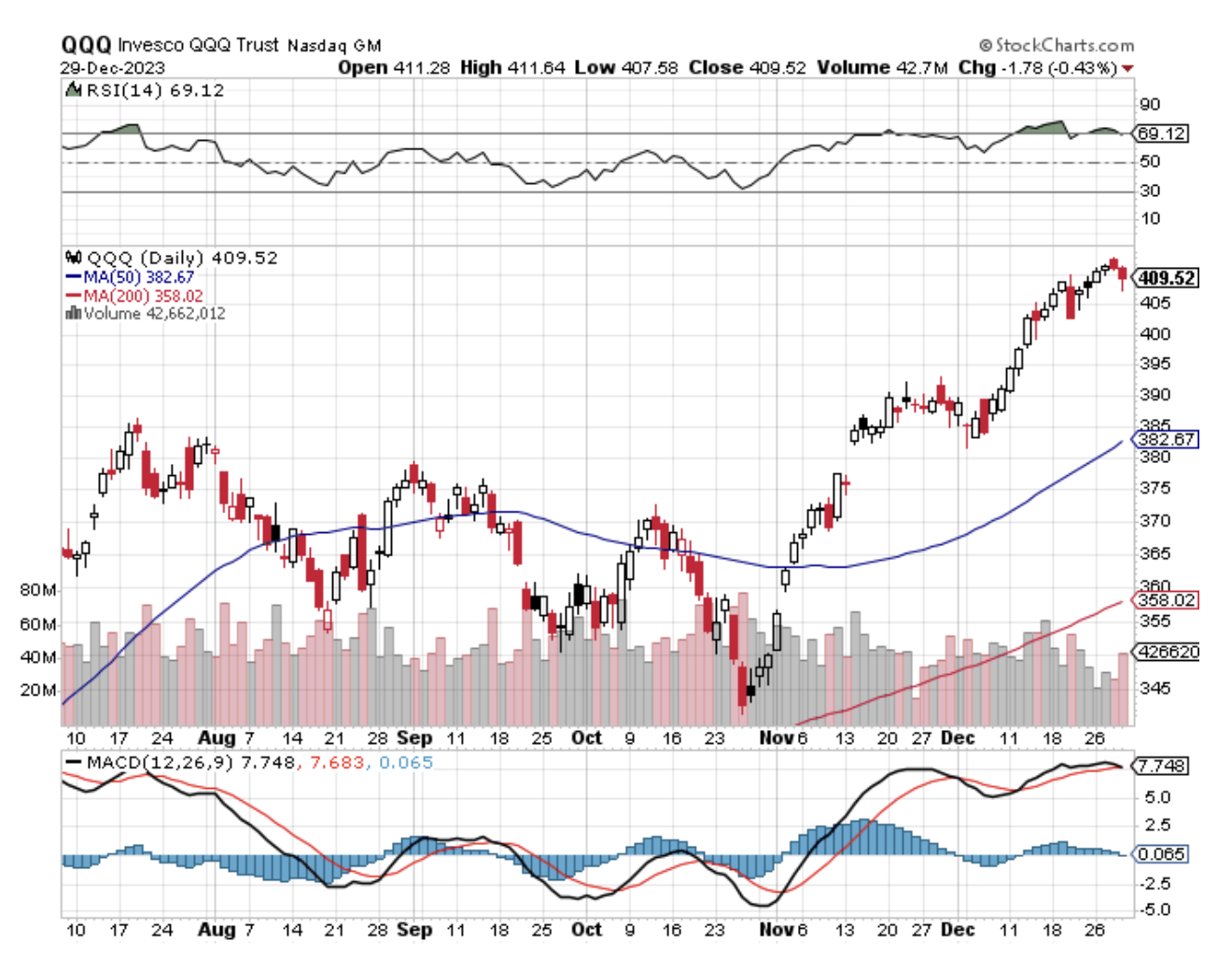
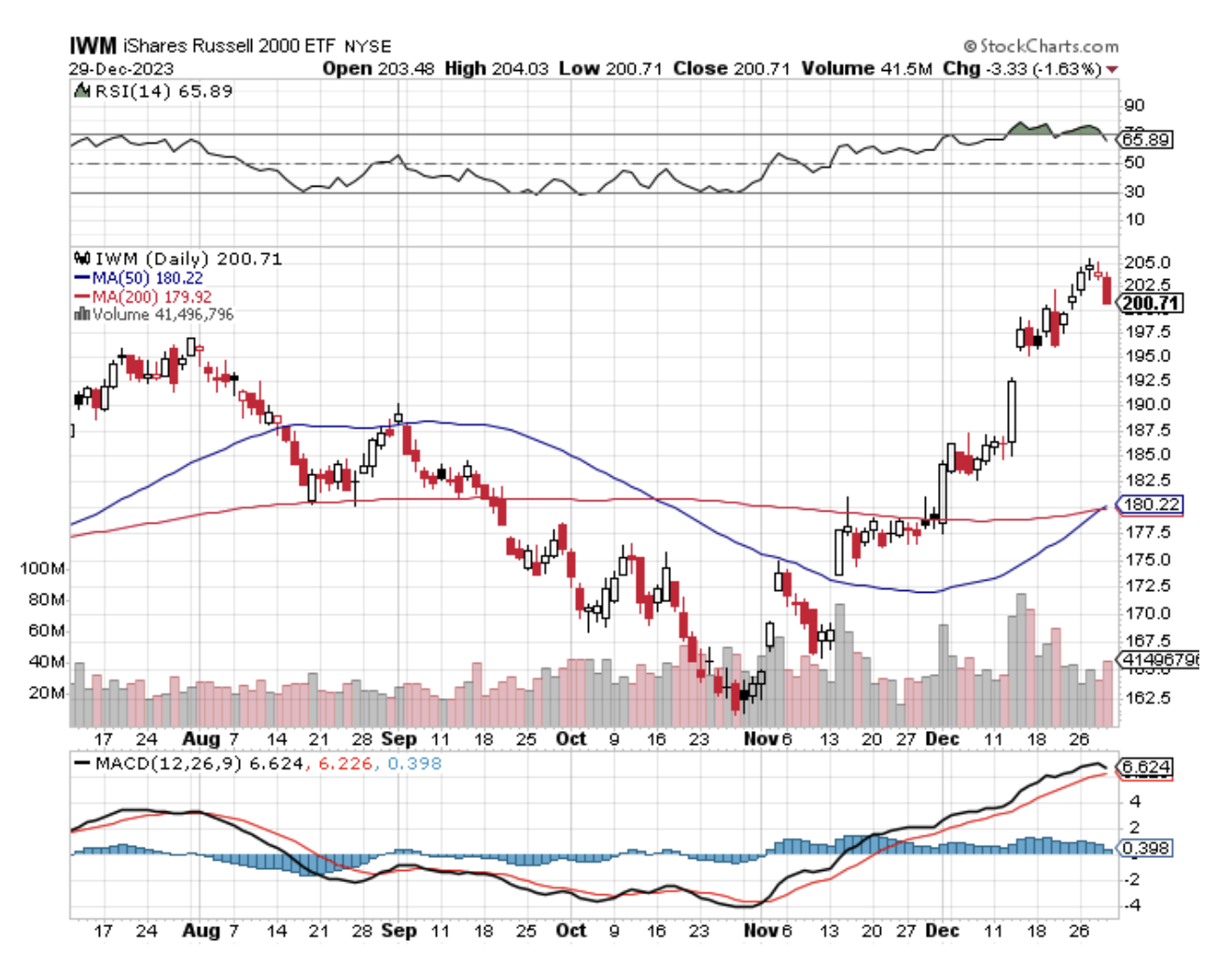
3) Bonds (TLT), (TBT), (JNK), (PHB), (HYG), (MUB), (LQD)
Amtrak needs to fill every seat in the dining car to get everyone fed on time, so you never know who you will share a table with for breakfast, lunch, and dinner.
There was the Vietnam Vet Phantom Jet Pilot who now refused to fly because he was treated so badly at airports. A young couple desperately eloping from Omaha could only afford seats as far as Salt Lake City. After they sat up all night, I paid for their breakfast.
A retired British couple was circumnavigating the entire US in a month on a “See America Pass.” Mennonites returning home by train because their religion forbade automobiles or airplanes.
The old bond trade is dead.
Long live the new bond trade!
After selling short bonds (TLT) from $180 all the way down to $82, I flipped to the long side on October 17. The next week, bonds saw their biggest rally in history, making instant millionaires out of several of my followers. The (TLT) has since rocketed from $82 to an eye-popping $100, a 22% gain.
In a heartbeat, we went from super bear to hyper bull.
I am looking for the Fed to cut interest rates by 1.00% in 2024 but won’t begin until the second half of the year. All of the first half bond gains were pulled forward into 2023 so I am looking for long periods of narrow trading ranges. By June, economic weakness will be so obvious that a dramatic Fed rate-cutting policy will ensue.
In addition, the Fed will end its quantitative tightening program by June, which is currently sucking $90 billion a month out of the economy. That’s a lot of bond-selling that suddenly ends.
I’m looking for $120 in the (TLT) sometime in 2024, with a possible stretch to $130. Use every five-point dip to load up on shares in the (TLT) ETF, calls, call spreads, and one-year LEAPS. This trade is going to work fast. It is the low-hanging fruit of 2024.
We are never going back to the 0.32% yields, and $165 prices we saw in the last bond peak. But you can still make a lot of money in a run-up from $82 to $120, as many happy bondholders are now discovering.
It isn’t just bonds that are going up. The entire interest rate space is doing well including junk bonds (JNK), municipal bonds (MUB), REITS (NLY), preferred stock, and convertible bonds.

A Visit to the 19th Century

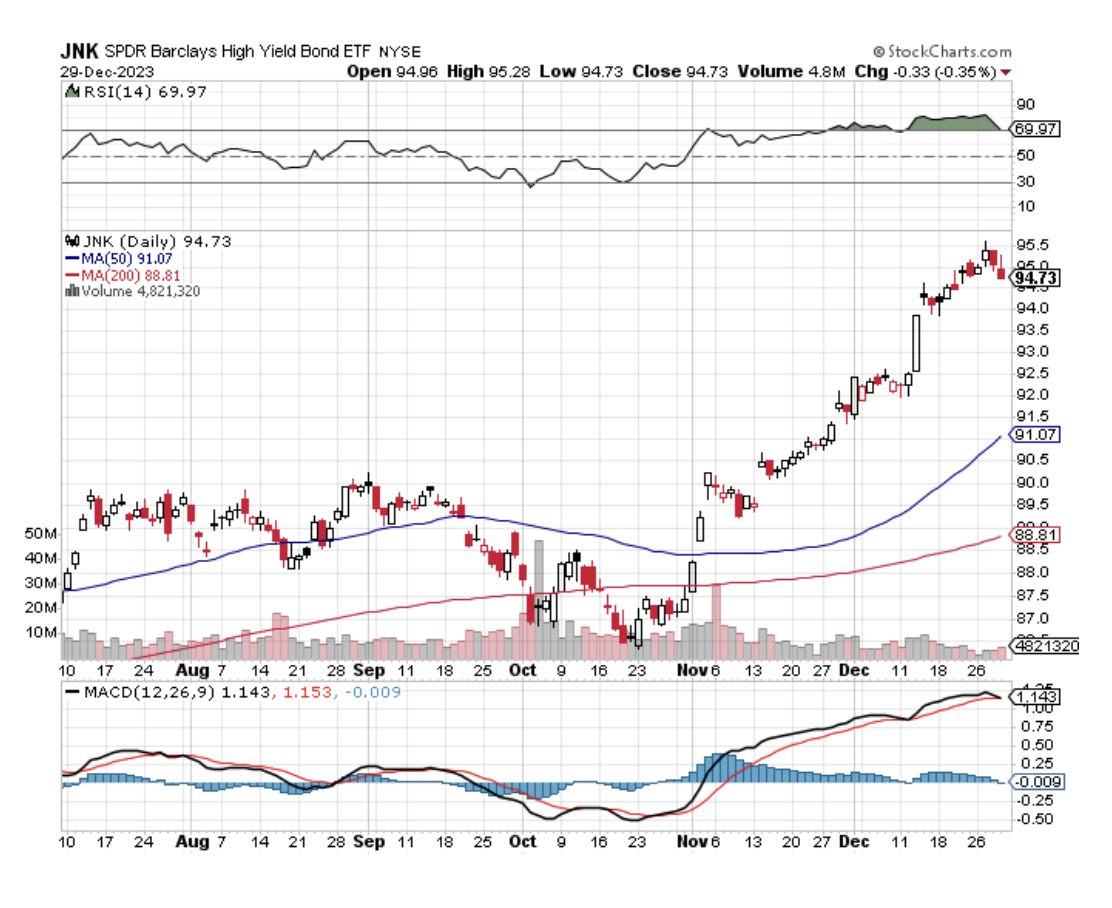
4) Foreign Currencies (FXE), (EUO), (FXC), (FXA), (YCS), (FXY), (CYB)
With a major yield advantage over the rest of the world for the last decade, the US dollar has been on an absolute tear. After all, the world’s strongest economy begets the world’s strongest currency.
That is about to end.
If your primary assumption is that US interest rates will see a sharp decline sometime in 2024, then the outlook for the greenback is terrible.
Currencies are driven by interest rate differentials and the buck is soon going to see the fastest shrinking yield premium in the forex markets.
That shines a great bright light on the foreign currency ETFs. You could do well buying the Australian Dollar (FXA), Euro (FXE), Japanese yen (FXE), and British Pound (FXB). I’d pass on the Chinese yuan (CYB) right now until their Covid shutdowns end.
Look at the 50-year chart of the US dollar index below and you’ll see that a 13-year uptrend in the buck is rolling over and will lead to a 5-10-year down move. Draw your weapons.

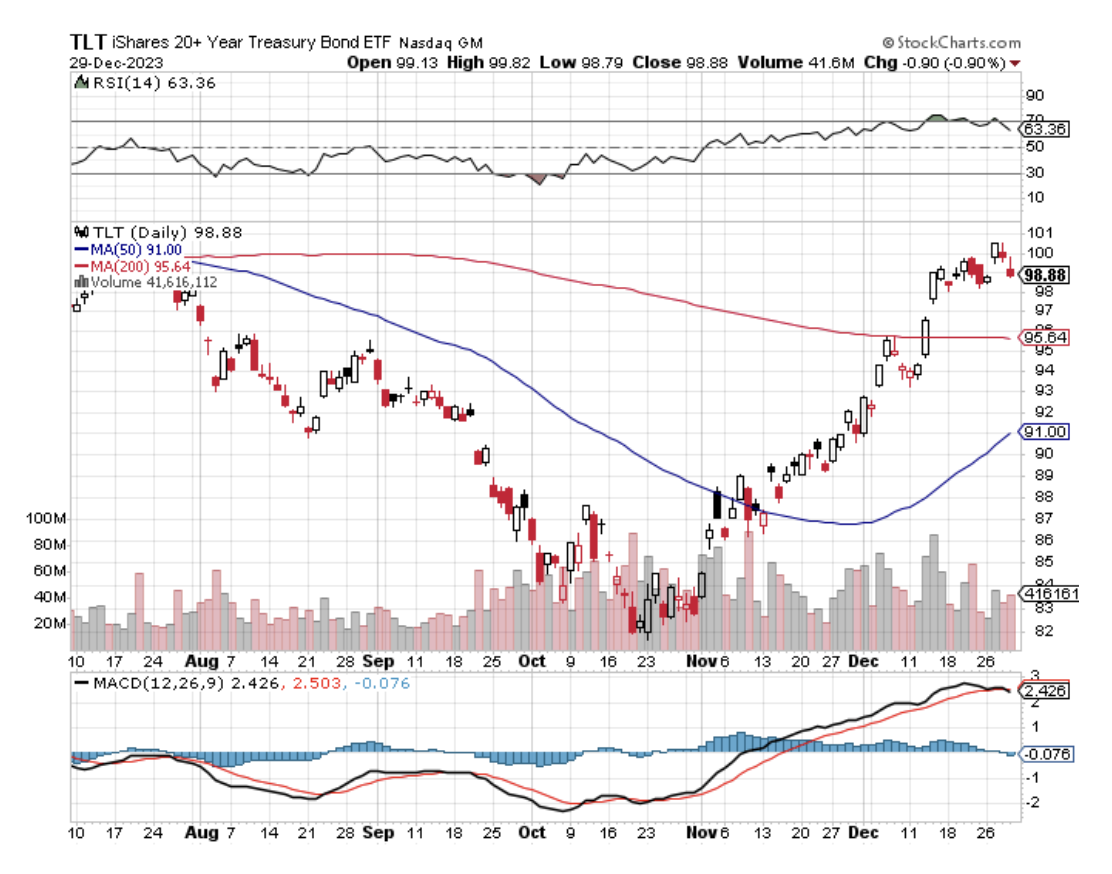
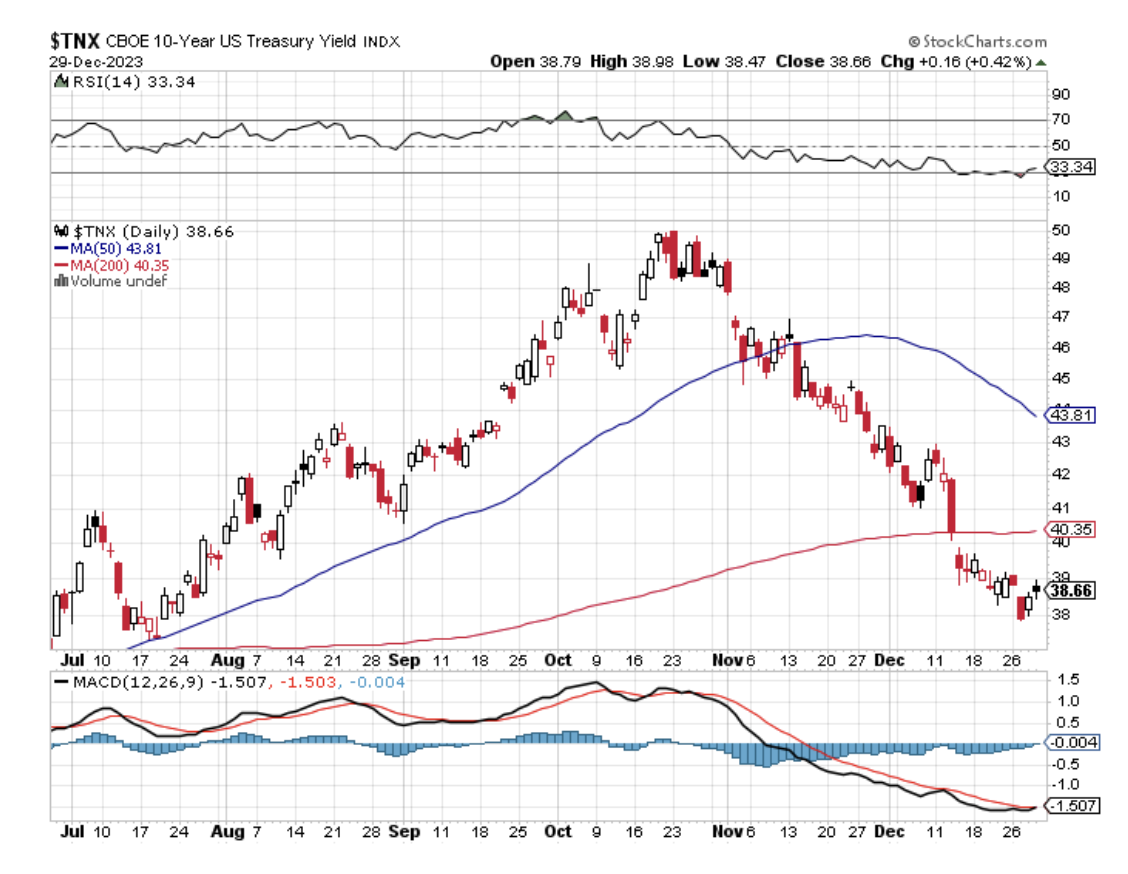
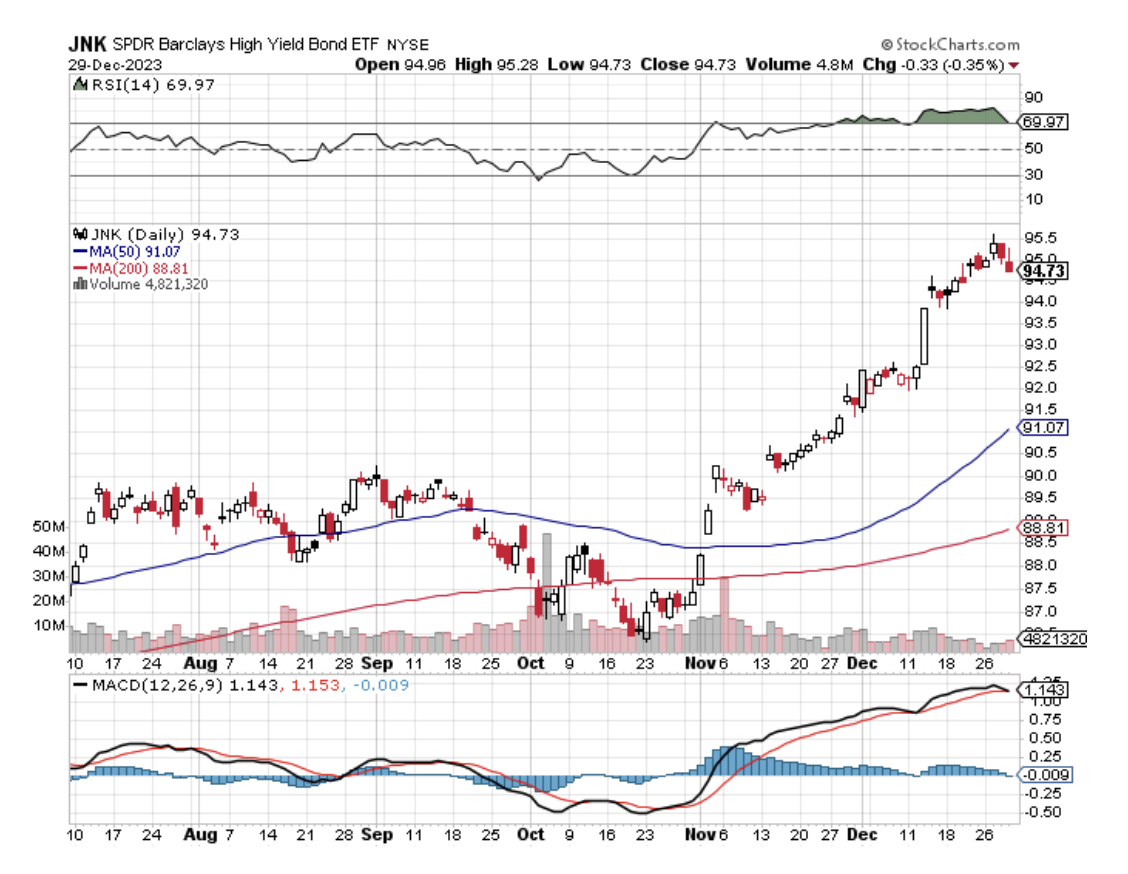

5) Commodities (FCX), (VALE), (DBA)
Commodities are the high beta players in the financial markets. That’s because the cost of being wrong is so much higher. Get on the losing side of commodities and you will be bled dry by storage costs, interest expenses, contangos, and zero demand.
Commodities have one great attribute. They predict recessions and recoveries earlier than any other asset class. When they peaked in March of 2022, they were screaming loud and clear that a recession would hit in early 2023. By reversing on a dime on November 13, 2023, they also told us that a rip-roaring recovery would begin in 2024.
You saw this in every important play in the sector, including Broken Hill (BHP), Peabody Energy (BTU), and Freeport McMoRan (FCX). And who but me noticed that Alcoa Aluminum (AA) was up an incredible 50% in December? Maybe you can’t teach an old dog new tricks, but the old tricks work pretty darn well!
The heady days of the 2011 commodity bubble top are about to replay. Now that this sector is convinced of a substantially weaker US dollar and lower inflation, it is once more a favorite target of traders.
China will finally rejoin the global economy as a growth engine in 2024 but at only half its previous growth rate. It will be replaced by India, which is turning into the new China and is now the most populous country in the world.
And here’s another big new driver. Each electric vehicle requires 200 pounds of copper and production is expected to rise from 2 million units a year to 20 million by 2030. Annual copper production will have to increase three-fold in a decade to accommodate this increase, no easy task or prices will have to rise.
The great thing about commodities is that it takes a decade to bring new supply online, unlike stocks and bonds, which can merely be created by an entry in an Excel spreadsheet. As a result, they always run far higher than you can imagine.
Accumulate all commodities on dips.
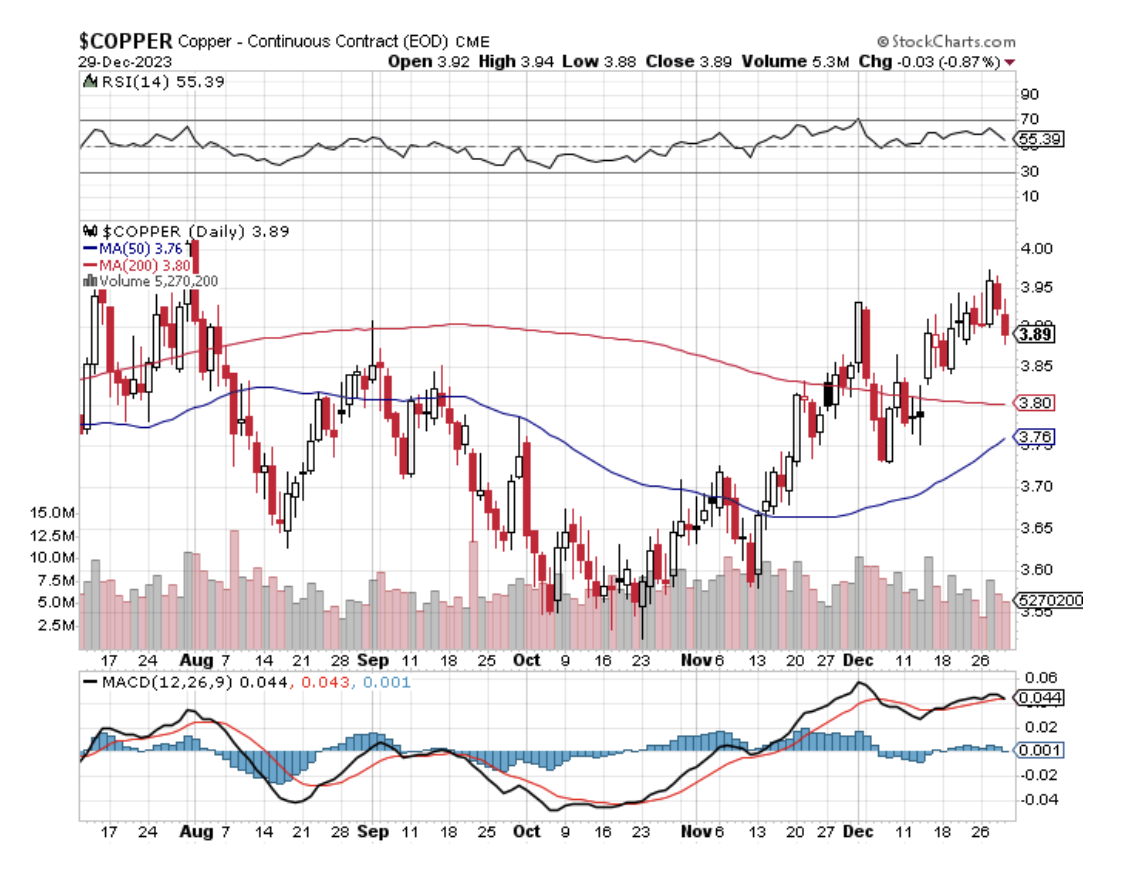
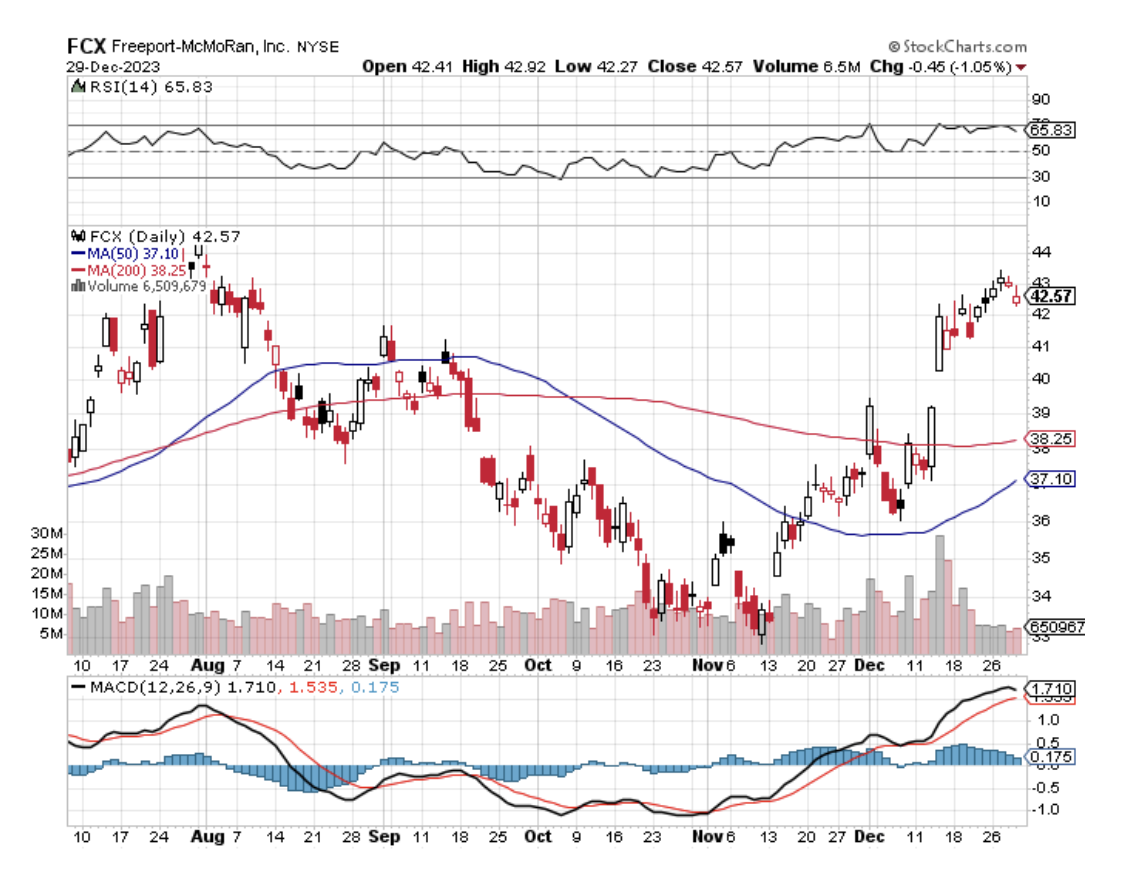

6) Energy (DIG), (RIG), (USO), (DUG), (UNG), (USO), (XLE), (AMLP)
Energy was the top-performing sector of 2023 until it wasn’t.
We got a nice boost to $90 a barrel from the Gaza War. But that faded rapidly as there was never an actual supply disruption, just the threats of one. Saudi production has been cut back so far, some 5 million barrels a day, that it risks budget shortfalls if it reduces any more. In the meantime, US fracking production has taken off like a rocket.
In the meantime, Joe Biden is sitting on the bid in an effort to refill the Strategic Petroleum Reserves that was drawn down from 723 to 350 million barrels during the last price spike.
The trade here is to buy any energy plays when Texas tea approaches $70 and take profits at $95. Your first picks should be ExxonMobile (XOM), Occidental Petroleum (OXY) where Warren Buffet has a 27% stake, Diamondback Energy (FANG), and Devon Energy (DVN).
The really big energy play for 2024 will be in natural gas (UNG), which was slaughtered in 2023. The problem here was not a shortage of demand because China would take all we could deliver. It was in our ability to deliver, hobbled by the lack of gasification facilities needed to export. One even blew up.
In 2024 several new export facilities came online and the damaged one was repaired. That should send prices soaring. Natural gas prices now at a throw-away $2.00 per MM BTU could make it to $8.00 in the next 12 months. That takes the (UNG) from $5.00 to $15.00 (because of the contango).
Buy (UNG) LEAPS (Long Term Equity Anticipation Securities) right now.
Remember, you will be trading an asset class that is eventually on its way to zero sooner than you think. However, you could have several doublings on the way to zero. This is one of those times. And you also have a huge 35% contango headwind working against you all the time.
They call this commodity the “widow maker” for a good reason.
The real tell here is that energy companies are bailing on their own industry. Instead of reinvesting profits back into their future exploration and development, as they have for the last century, they are paying out more in dividends and share buybacks.
Take the money and run. Trade, don’t marry this asset class.
There is the additional challenge in that the bulk of US investors, especially environmentally friendly ESG funds, are now banned from investing in legacy carbon-based stocks. That means permanently cheap valuations and share prices for the energy industry.
Energy now counts for only 5% of the S&P 500. Twenty years ago, it boasted a 15% weighting.
The gradual shutdown of the industry makes the supply/demand situation infinitely more volatile.
To understand better how oil might behave in 2024, I’ll be studying US hay consumption from 1900-1920. That was when the horse population fell from 100 million to 6 million, all replaced by gasoline-powered cars and trucks.
The internal combustion engine is about to suffer the same fate.
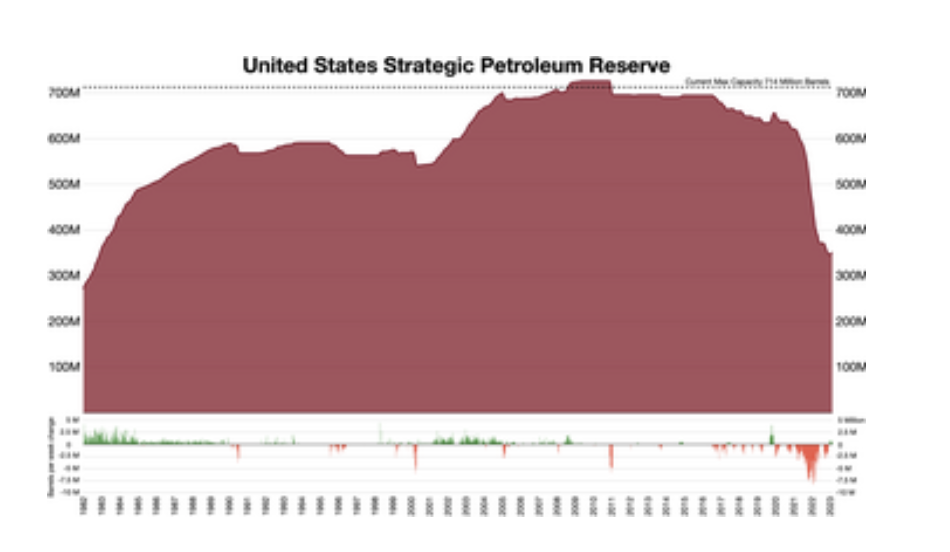
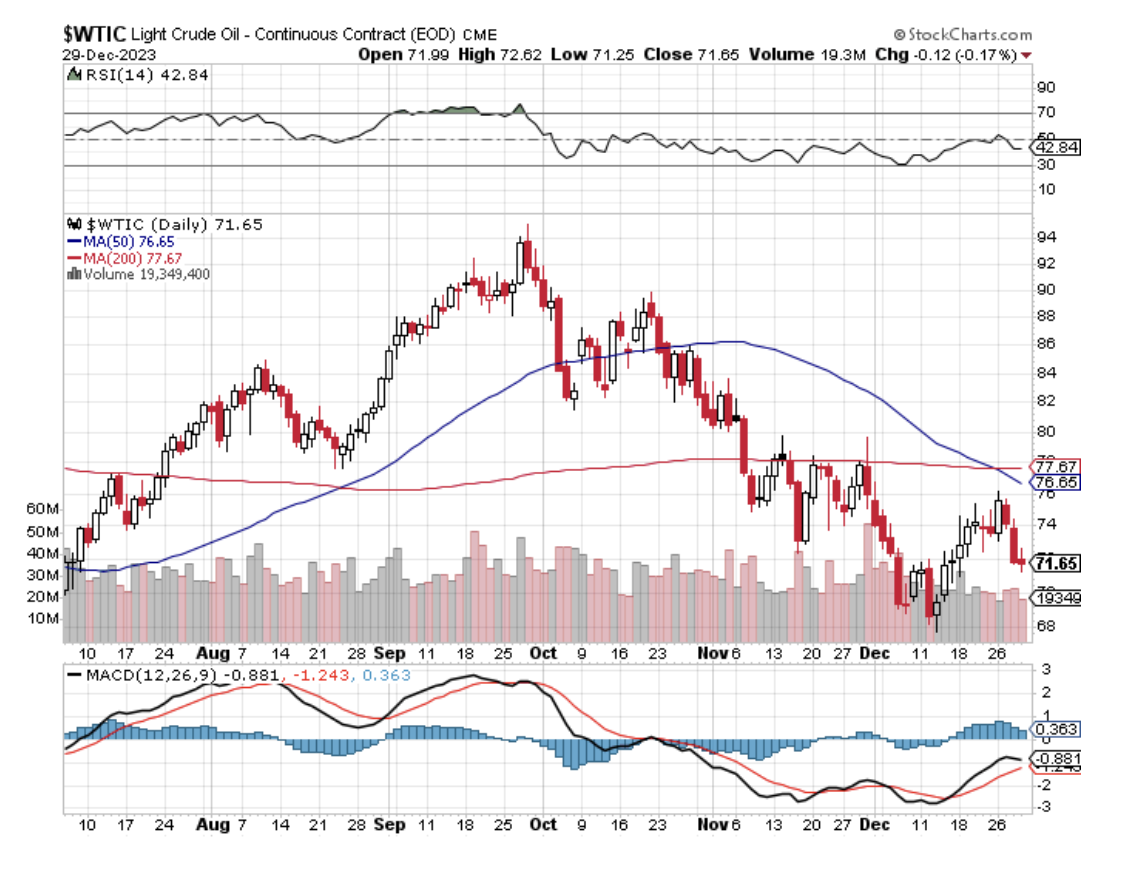
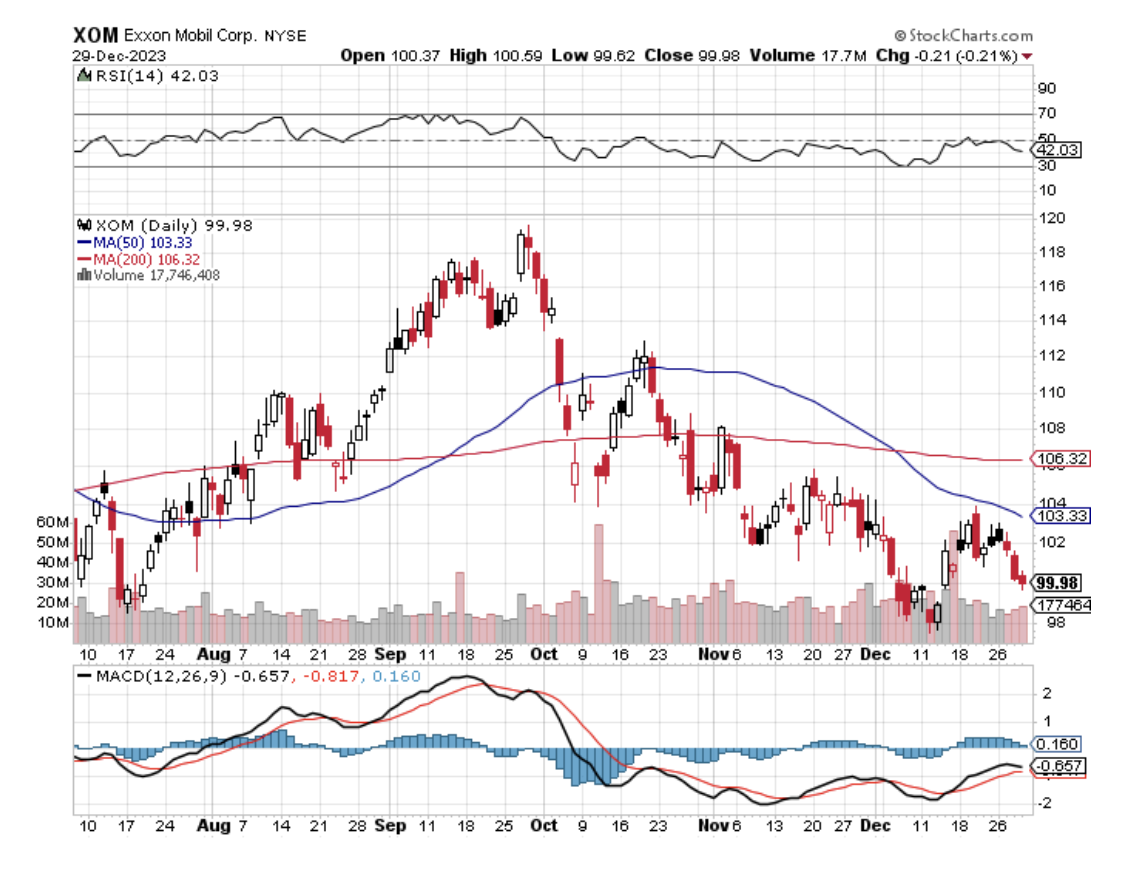

7) Precious Metals (GLD), (DGP), (SLV), (PPTL), (PALL)
The train has added extra engines at Denver, so now we may begin the long laboring climb up the Eastern slope of the Rocky Mountains.
On a steep curve, we pass along an antiquated freight train of hopper cars filled with large boulders.
The porter tells me this train is welded to the tracks to create a windbreak. Once, a gust howled out of the pass so swiftly, that it blew a passenger train over on its side.
In the snow-filled canyons, we saw a family of three moose, a huge herd of elk, and another group of wild mustangs. The engineer informs us that a rare bald eagle is flying along the left side of the train. It’s a good omen for the coming year.
We also see countless abandoned 19th-century gold mines and broken-down wooden trestles leading to huge piles of tailings, and relics of previous precious metals booms. So, it is timely here to speak about the future of precious metals.
Here it’s important to look at the long view on gold. The barbarous relic tends to have good and bad decades. During the 2000’s the price of the yellow metal rose tenfold, from $200 to $2,000. The 2010s were very boring when gold was unchanged. Gold is doing well this decade, already up 40%, and a double or triple is in the cards.
2023 should have been a terrible year for precious metals. With inflation soaring, stocks volatile, and interest rates soaring, gold had every reason to collapse. Instead, it was up on the year, thanks to a heroic $325, 17.8%% rally in the last two months.
The reason is falling interest rates, which reduce the opportunity costs of owning gold. The yellow metal doesn’t pay a dividend, costs money to store and insure, and delivery is an expensive pain in the butt.
Chart formations are looking very encouraging with a massive upside breakout in place. So, buy gold on dips if you have a stick of courage on you, which you must if you read this newsletter.
Of course, the best investors never buy gold during a bull market. They Hoover up gold miners, which rise four times faster, like Barrack Gold (GOLD), Newmont Mining (NEM), and the basket play Van Eck Vectors Gold Miners ETF (GDX).
Higher beta silver (SLV) will be the better bet, as it already has been because it plays a major role in the decarbonization of America. There isn’t a solar panel or electric vehicle out there without some silver in them and the growth numbers are positively exponential. Keep buying (SLV), (SLH), and (WPM) on dips.
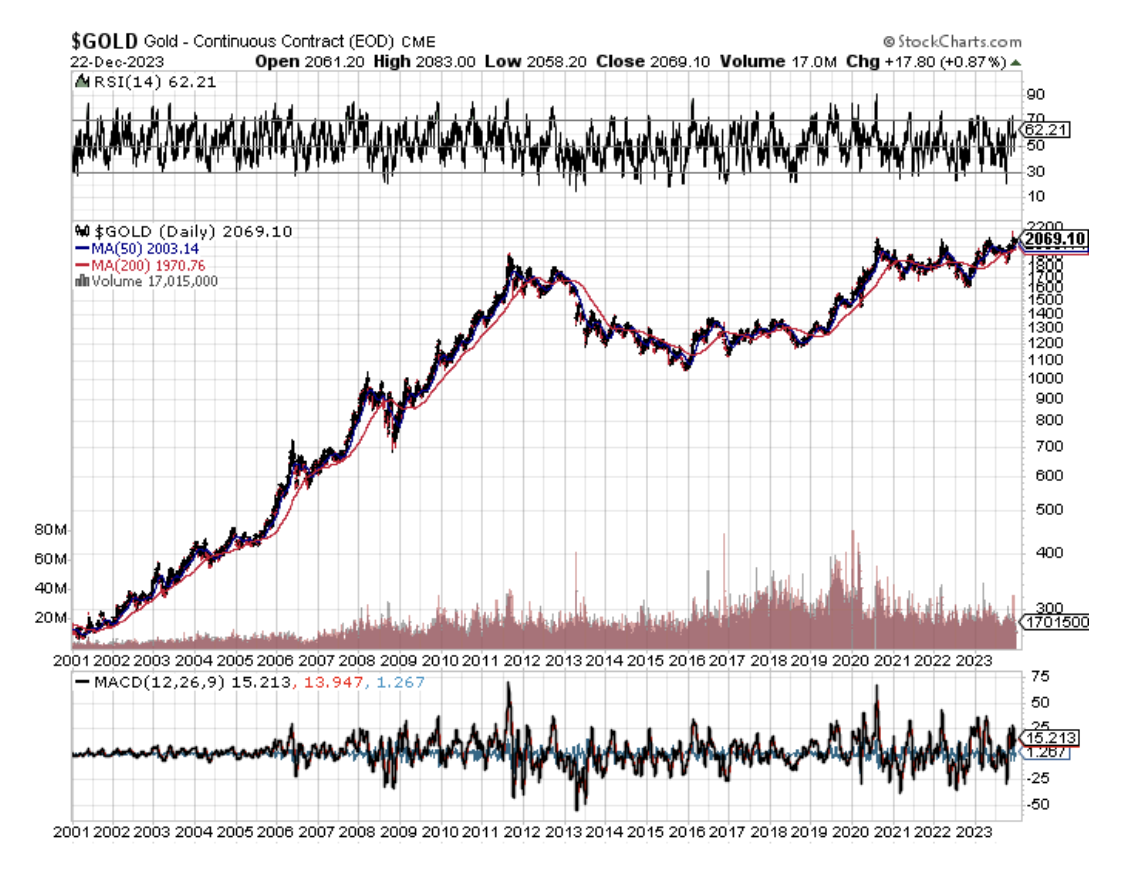
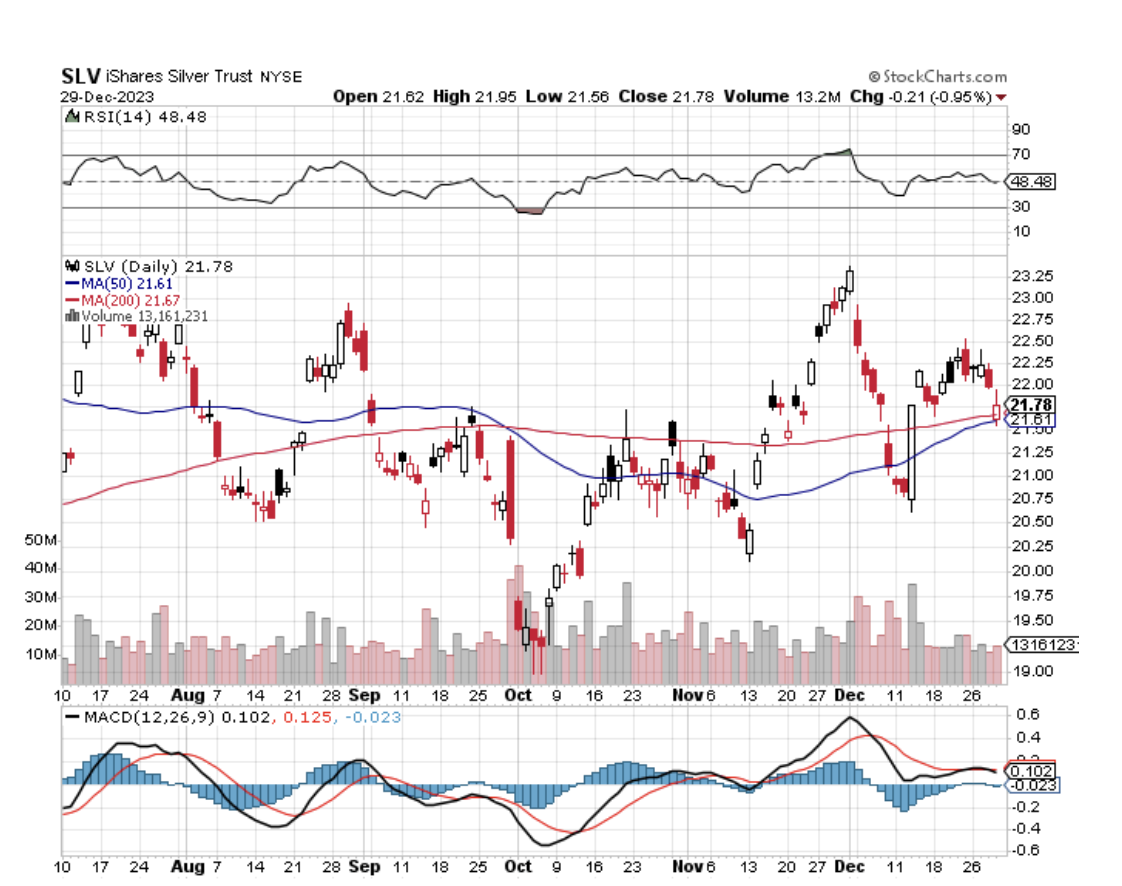

8) Real Estate (ITB), (LEN), (KBH), (PHM)
The majestic snow-covered Rocky Mountains are behind me. There is now a paucity of scenery, with the endless ocean of sagebrush and salt flats of Northern Nevada outside my window, so there is nothing else to do but write.
My apologies in advance to readers in Wells, Elko, Battle Mountain, and Winnemucca, Nevada.
It is a route long traversed by roving bands of Indians, itinerant fur traders, the Pony Express, my own immigrant forebearers in wagon trains, the Transcontinental Railroad, the Lincoln Highway, and finally US Interstate 80, which was built for the 1960 Winter Olympics at Squaw Valley.
Passing by shantytowns and the forlorn communities of the high desert, I am prompted to comment on the state of the US real estate market.
Those tormented by the shrinking number of real estate transactions over the past two years take solace. The past excesses have been unwound and we are now on the launching pad for another decade-long bull market.
There is a generational structural shortage of supply with housing which won’t come back into balance until the 2030’s. You don’t have a real estate crash when we are short 10 million homes.
The reasons, of course, are demographic. There are only three numbers you need to know in the housing market for the next ten years: there are 80 million baby boomers, 65 million Generation Xers who follow them, and 86 million in the generation after that, the Millennials.
The 76 million baby boomers (between ages 62 and 79) have been unloading dwellings to the 72 million Gen Xers (between age 41 and 56) since prices peaked in 2007. But there are not enough of the latter, and three decades of falling real incomes mean that they only earn a fraction of what their parents made. That’s what caused the financial crisis. That has created the present shortage of housing, both for ownership and rentals.
There is a happy ending to this story.
The 72 million Millennials now aged 25-40 are now the dominant buyers in the market. They are transitioning from 30% to 70% of all new buyers of homes. They are also just entering the peak spending years of middle age, which is great for everyone. Hot on their heels are 68 million Gen Z, which are now 12 to 27 years old.
The Great Millennial Migration to the suburbs and Middle America has just begun. Thanks to the pandemic and Zoom, many are never returning to the cities. That has prompted massive numbers to move from the coasts to the American heartland.
That’s why Boise, Idaho was the top-performing real estate market in 2023, followed by Phoenix, Arizona. Personally, I like Reno, Nevada, where Apple, Google, Amazon, and Tesla are building factories as fast as they can, just a four-hour drive from Silicon Valley.
As a result, the price of single-family homes should continue to rise during the 2020s, as they did during the 1970s and the 1990s when identical demographic forces were at play.
This will happen in the context of a labor shortfall, rising wages, and improving standards of living.
Increasing rents are accelerating this trend. Renters now pay 35% of their gross income, compared to only 18% for owners, and less, when multiple deductions and tax subsidies are considered. Rents are now rising faster than home prices.
Remember, too, that the US will not have built any new houses in large numbers in 17 years. The 50% of small home builders that went under during the Financial Crisis never came back.
We are still operating at only half of the 2007 peak rate. Thanks to the Great Recession, the construction of five million new homes has gone missing in action.
There is a new factor at work. We are all now prisoners of the 2.75% 30-year fixed-rate mortgages we all obtained over the past five years. If we sell and try to move, a new mortgage will cost double today. If you borrow at a 2.75% 30-year fixed rate, and the long-term inflation rate is 3%, then, over time, you will get your house for free. That’s why nobody is selling, and prices have barely fallen.
This winds down in 2024 as the Fed realizes its many errors and sharply lowers interest rates. Home prices will explode…. again.
Quite honestly, of all the asset classes mentioned in this report, purchasing your abode is probably the single best investment you can make now after you throw in all the tax breaks. It’s also a great inflation play.
That means the major homebuilders like Lennar (LEN), Pulte Homes (PHM), and KB Homes (KBH) are a buy on the dip. But don’t forget to sell your home by the 2030s when the next demographic headwind resumes. That’s when you should unload your home to a Millennial or Gen Xer and move into a cheap rental.
A second-hand RV would be better.


9) Postscript
We have pulled into the station at Truckee amid a howling blizzard.
My loyal staff have made the ten-mile trek from my estate at Incline Village to welcome me to California with a couple of hot breakfast burritos and a chilled bottle of Dom Perignon Champagne, which has been resting in a nearby snowbank. I am thankfully spared from taking my last meal with Amtrak.

After that, it was over legendary Donner Pass, and then all downhill from the Sierras, across the Central Valley, and into the Sacramento River Delta.
Well, that’s all for now. We’ve just passed what was left of the Pacific mothball fleet moored near the Benicia Bridge (2,000 ships down to six in 50 years). The pressure increase caused by a 7,200-foot descent from Donner Pass has crushed my plastic water bottle. Nice science experiment!
The Golden Gate Bridge and the soaring spire of Salesforce Tower are just coming into view across San Francisco Bay.
A storm has blown through, leaving the air crystal clear and the bay as flat as glass. It is time for me to unplug my MacBook Pro and iPhone 15 Pro, pick up my various adapters, and pack up.
We arrive in Emeryville 45 minutes early. With any luck, I can squeeze in a ten-mile night hike up Grizzly Peak and still get home in time to watch the ball drop in New York’s Times Square on TV.
I reach the ridge just in time to catch a spectacular pastel sunset over the Pacific Ocean. The omens are there. It is going to be another good year.
I’ll shoot you a Trade Alert whenever I see a window open at a sweet spot on any of the dozens of trades described above, which should be soon.
Good luck and good trading in 2024!
John Thomas
The Mad Hedge Fund Trader





Global Market Comments
November 17, 2023
Fiat Lux
Featured Trade:
(NOVEMBER 15 BIWEEKLY STRATEGY WEBINAR Q&A),
(TLT), (AMD), (SPY), (FXA), (WYNN), (MGM), (RCL), (CCL), (TSLA), (SCHW), (BLK), (JPM), (XHB), (TSLA), (FXI), (FCX)
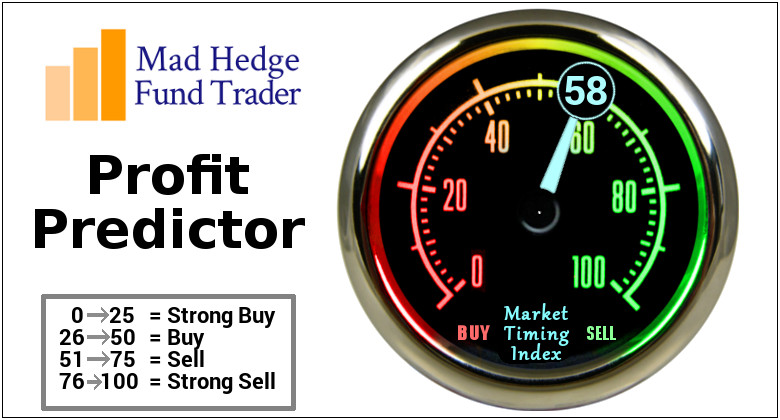
Below please find subscribers’ Q&A for the November 15 Mad Hedge Fund Trader Global Strategy Webinar, broadcast from Incline Village, NV.
Q: I was a little surprised that you closed the (TLT) $79-$82 vertical bull call spread so early. Why not wait longer?
A: I took an 84% profit in only four trading days and skipped the last 16% which I would have had to wait another month to get. I was much better off putting on another position and making another 100%. In this kind of market, you want to take quick profits and then roll them into new positions as fast as you can. That’s where you make the big money, and that's what we’ve been doing. You have to strike when the iron is hot.
Q: November’s results are phenomenal!
A: Yes they are, 55 years of practice makes it easy.
Q: Thoughts on Advanced Micro Devices (AMD)?
A: It’s going higher. I think the whole semiconductor sector is the leading sector in the market; we have seen that with these gigantic 30-40% moves in the semis. That will continue, and then it will spread out to the rest of big tech (which it’s already done), and eventually, we get to the industrials and commodities in the second half of 2024 when the big economic growth returns. So that is the script for the coming year.
Q: Will the upcoming Fed interest rate cuts crash the dollar, and which emerging currency should I buy?
A: Yes and yes. It will crush the dollar–we could be entering a new decade of a falling U.S. dollar. The number one currency to buy is the Australian dollar (FXA). It has the most leverage for a global economic recovery. And you can see when we get to the currency section of today’s webinar that the currencies are already starting to move. Whatever currency has falling interest rates is always the weakest, and the U.S. dollar is about to become just that.
Q: What’s the deal with casino stocks lately like Wynn Resorts (WYNN) and MGM Resorts International (MGM)?
A: These companies took on massive amounts of debt during the pandemic to stay in business, so they are now highly sensitive to interest rates. If you look at the collapse of these stocks in the last four months, it is almost perfectly in sync with rising interest rates, and that’s why the stocks performed so poorly. By the way, the same is true for all the cruise companies like Royal Caribbean (RCL), and Carnival (CCL). The flip side of that is when interest rates start to go down these stocks do great, and they are falling interest rate plays, so you probably should be buying the casinos, the cruise lines, and the hotel stocks here because they are all suffering from massive debt loads, the cost of which is about to decline sharply.
Q: Should we roll up the expiration of LEAPS to 2026?
A: Probably not a bad idea, because we may get weakness in commodities for the next several months before we enter a massive new bull market. If you have the 2025, you’ll probably make money on that, but to be ultra-safe you could roll it forward to 2026. We know there’s a global copper shortage developing because of EVs, but right now EV sales are slow, so you don’t want to be piling onto the leverage plays on that too soon. That’s also why I am not in Tesla (TSLA) for the Moment.
Q: What will happen if the Fed cuts interest rates and there’s no recession? Won’t prices of everything from houses to butter go wild?
A: They won’t go wild, but they will go up at a 2% inflation rate, which is what the Fed wants. And house prices, which have been flat for the last year, will rise. And they may rise greater than the inflation rate of 2%; they may rise more like 5%. Falling interest rates mean falling mortgages; we’ve already seen mortgage rates drop from 8 to 7.4%. It's one of the sharpest drops in history, and more drops bring more first-time home buyers into the market. And don’t forget that the Fed could also raise interest rates down the road. If the economy gets too hot again, they may raise again, but I think we’ll see a lot of cuts first.
Q: Do you think financial stocks will go up or fall with potential rate decreases?
A: Banks always go up during falling interest rates because their cost of funds goes down and the default rate on their loans also goes down, so they get a hockey stick effect on earnings; that’s why you’re seeing such monster moves in stocks like JP Morgan (JPM) and the brokers (SCHW) as well as the money managers like BlackRock (BLK).
Q: Does the bull market keep going since unemployment still hasn’t made a dent, meaning consumers are fueling the rise in stocks?
A: Yes, consumer spending is still doing well. People seem to be getting the money from somewhere and it seems to be rising wages. But I expect wage gains to drop by half; people will still get wage increases, but not the peak levels that the UAW got in their deal with Detroit. Is a Goldilocks economy that is setting up, and the economy keeps growing We never do get a recession, and all risk assets rise as a result. That is the outlook!
Q: Bullish on Berkshire Hathaway (BRK/B)?
A: I completely agree, it’s one of the best-run companies in the world. 93-year-old Warren Buffet and 99-year-old Charlie Munger have delivered double the performance of the S&P 500 over the last three years.
Q: When does the IPO market come back to life, and which industries will benefit the most?
A: AI and Technology will benefit the most. There are several AI companies in the wings waiting to go public, and they will be the first out the door with the highest multiples, and then the IPO business will broaden out from there.
Q: Will a worsening Chinese property market blow up the U.S. Stock rally or is it just a fake risk I shouldn’t worry about?
A: The Chinese (FXI) real estate market is detached from the global economy. There is no international implication, and it’s also typical of emerging markets to overbuild and then have a financial collapse. Nobody I know has suffered anything in China in a long time, and if anything, they’re liquidating what little they have left. It doesn’t affect us at all. It’s interesting reading about it in the newspapers, and that’s about it.
Q: What are some stocks we should consider day trading these days?
A: None. Most people who try day trading lose money doing it; some people pull it off but they have many years of experience. Algorithms from big brokers have essentially taken over the day trading business with high-frequency trading. You do better on a one-month view, which I do on my front-month options. Most 2023 Stock Gains Happened in only eight days, up some 14% since January 1, and only seven stocks accounted for most of the increase. If you are a day trader, you most likely missed all of this because most of the moves were on gap openings.
Q: Home builders (XHB) have just had a great run, is this an area too short?
A: “Short” is a term you need to remove from your language! You don’t want to short a big bull move like this. If anything, wait until May when the summer seasonals start to favor short positions, and it depends on how high the market runs up until then. Don’t ever think about shorting the very beginning of a new bull market in stocks–not for housing, not for anything! And the outlook for housing over the long term looks fantastic; there’s still an overwhelming supply and demand in favor of the home builders. Some 85 million new Millennials need to buy first-time homes.
To watch a replay of this webinar with all the charts, bells, whistles, and classic rock music, just log in to www.madhedgefundtrader.com, go to MY ACCOUNT, select your subscription (GLOBAL TRADING DISPATCH, TECHNOLOGY LETTER, or Jacquie's Post), then click on WEBINARS, and all the webinars from the last 12 years are there in all their glory.
Good Luck and Stay Healthy,
John Thomas
CEO & Publisher
The Diary of a Mad Hedge Fund Trader
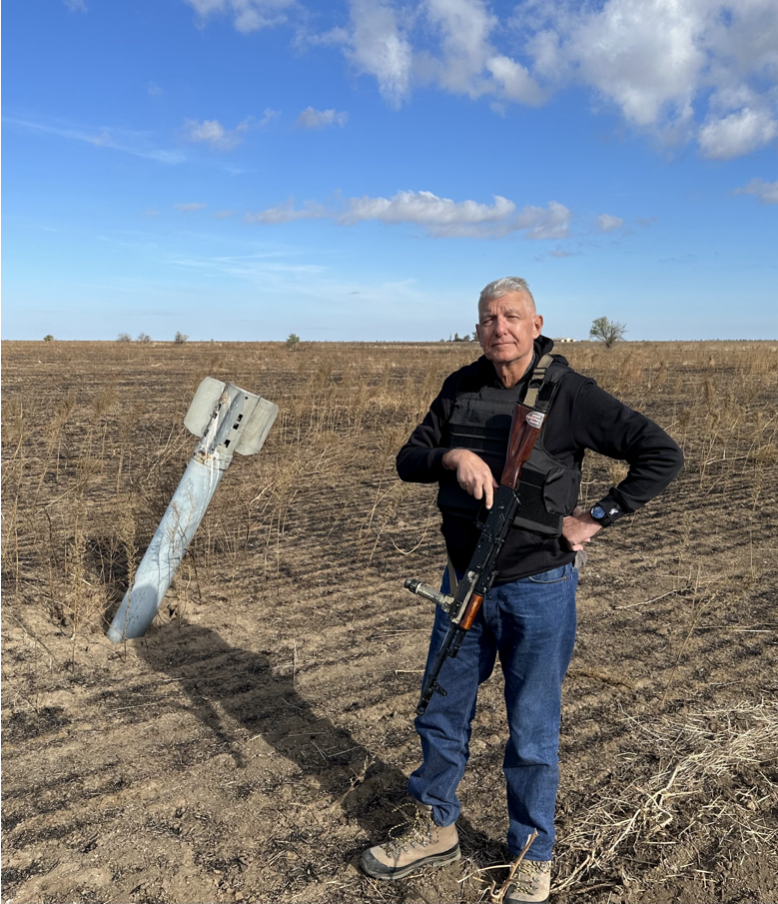
2023 Kherson Ukraine – Ha Ha Missed Me! It was a dud.

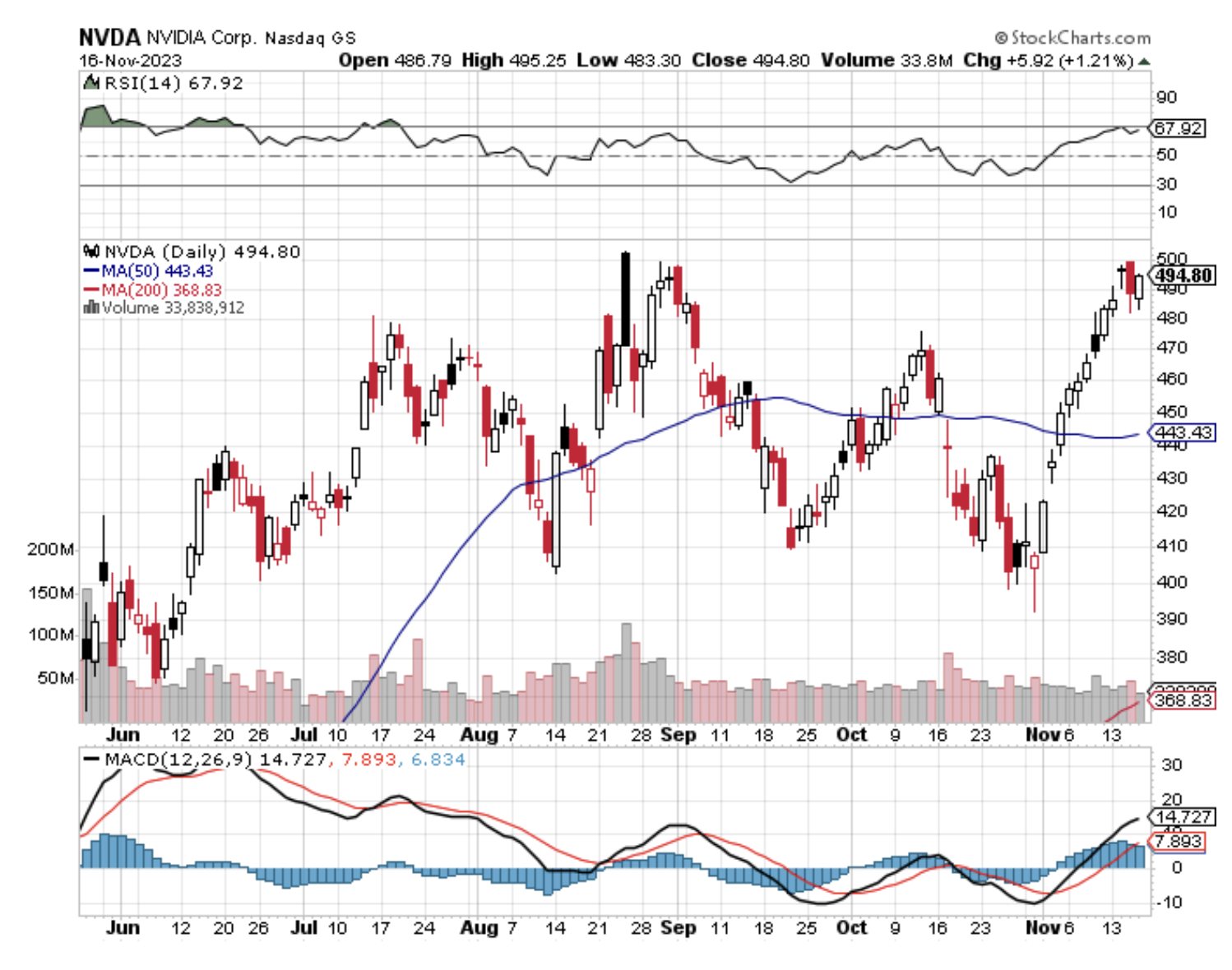
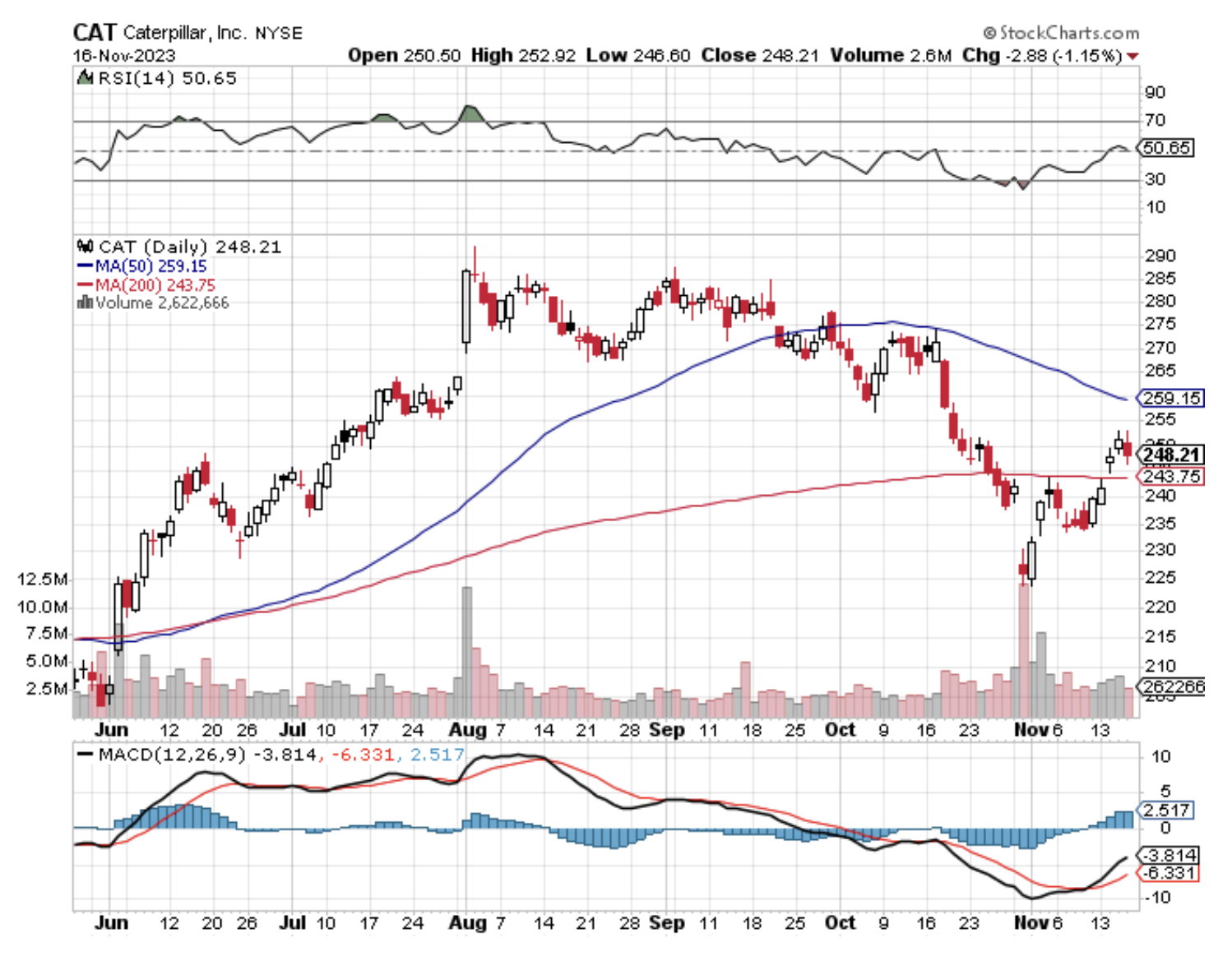
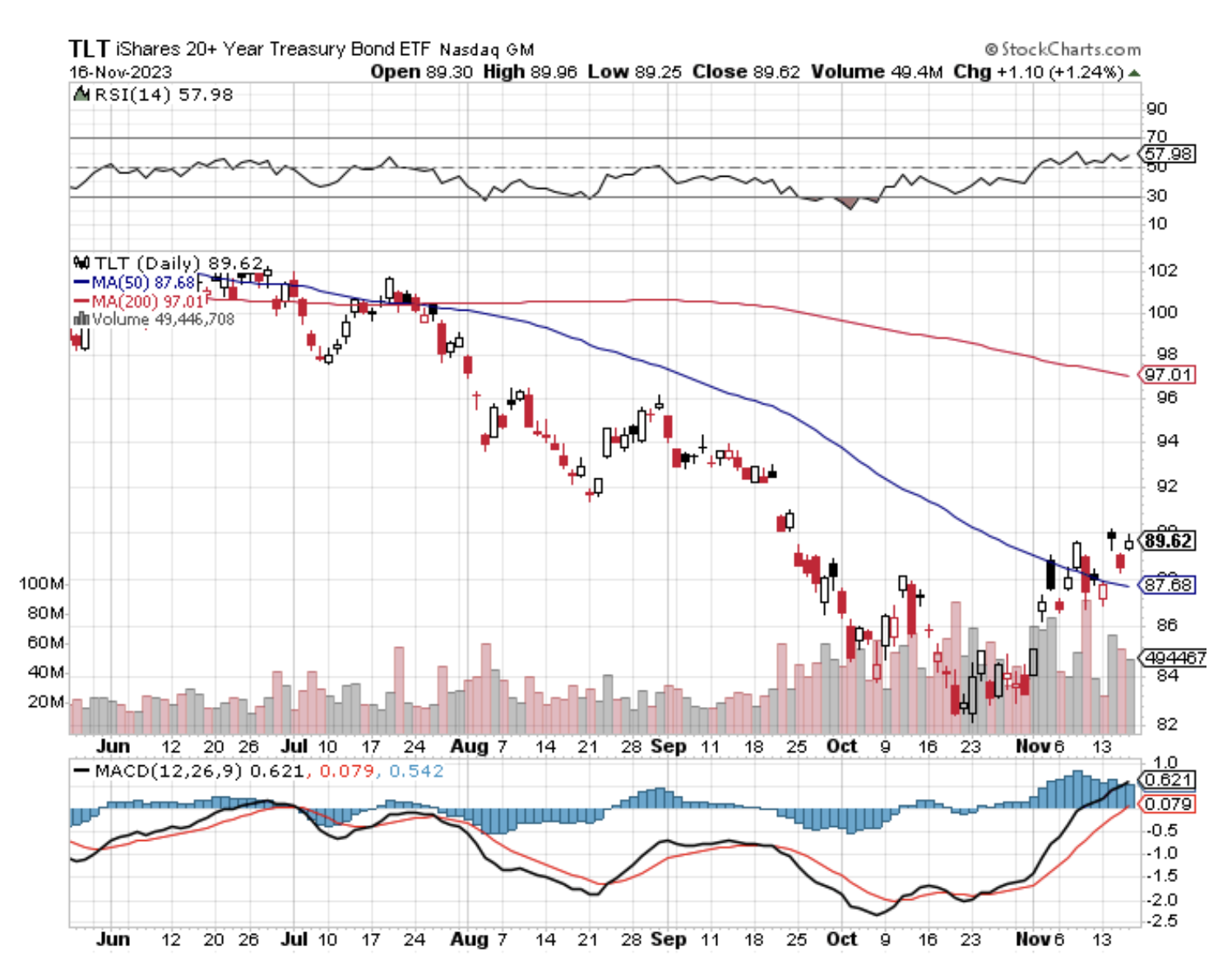
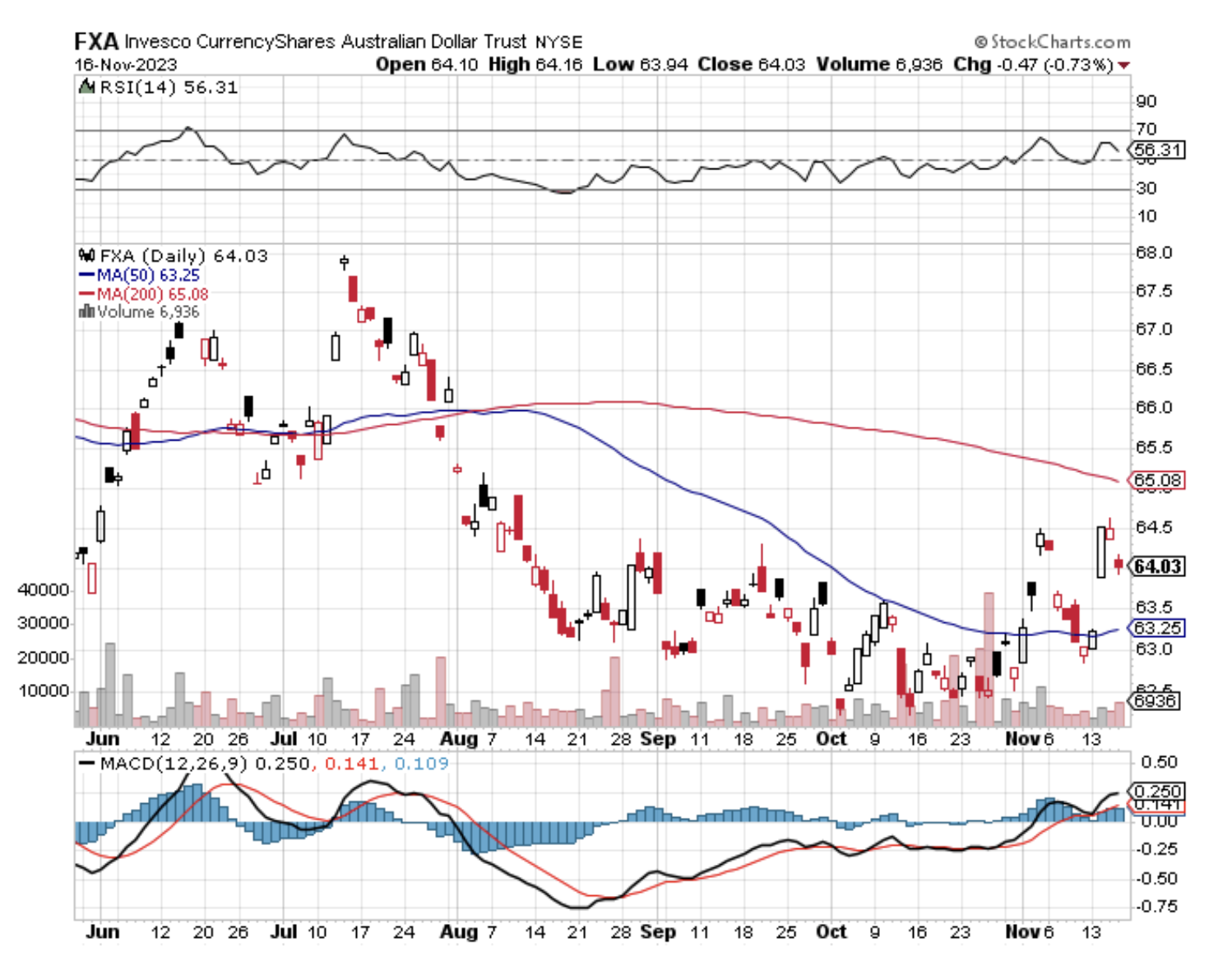
Global Market Comments
November 3, 2023
Fiat Lux
Featured Trade:
(NOVEMBER 1 BIWEEKLY STRATEGY WEBINAR Q&A),
(BRK/B), (TSLA), (LLY), (SNOW), (BIB), (BIB), (CCJ), (FXA), (FXB), (FXE), (EEM), (GLD), (SLV) (UNG), (LNG)
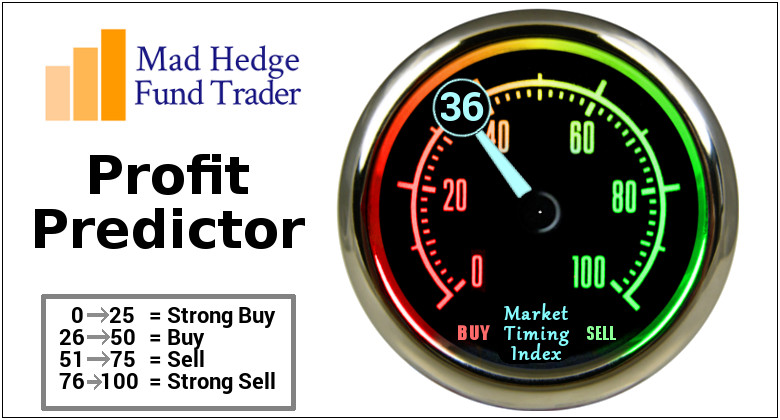
Legal Disclaimer
There is a very high degree of risk involved in trading. Past results are not indicative of future returns. MadHedgeFundTrader.com and all individuals affiliated with this site assume no responsibilities for your trading and investment results. The indicators, strategies, columns, articles and all other features are for educational purposes only and should not be construed as investment advice. Information for futures trading observations are obtained from sources believed to be reliable, but we do not warrant its completeness or accuracy, or warrant any results from the use of the information. Your use of the trading observations is entirely at your own risk and it is your sole responsibility to evaluate the accuracy, completeness and usefulness of the information. You must assess the risk of any trade with your broker and make your own independent decisions regarding any securities mentioned herein. Affiliates of MadHedgeFundTrader.com may have a position or effect transactions in the securities described herein (or options thereon) and/or otherwise employ trading strategies that may be consistent or inconsistent with the provided strategies.
This site uses cookies. By continuing to browse the site, you are agreeing to our use of cookies.
OKLearn moreWe may request cookies to be set on your device. We use cookies to let us know when you visit our websites, how you interact with us, to enrich your user experience, and to customize your relationship with our website.
Click on the different category headings to find out more. You can also change some of your preferences. Note that blocking some types of cookies may impact your experience on our websites and the services we are able to offer.
These cookies are strictly necessary to provide you with services available through our website and to use some of its features.
Because these cookies are strictly necessary to deliver the website, refuseing them will have impact how our site functions. You always can block or delete cookies by changing your browser settings and force blocking all cookies on this website. But this will always prompt you to accept/refuse cookies when revisiting our site.
We fully respect if you want to refuse cookies but to avoid asking you again and again kindly allow us to store a cookie for that. You are free to opt out any time or opt in for other cookies to get a better experience. If you refuse cookies we will remove all set cookies in our domain.
We provide you with a list of stored cookies on your computer in our domain so you can check what we stored. Due to security reasons we are not able to show or modify cookies from other domains. You can check these in your browser security settings.
These cookies collect information that is used either in aggregate form to help us understand how our website is being used or how effective our marketing campaigns are, or to help us customize our website and application for you in order to enhance your experience.
If you do not want that we track your visist to our site you can disable tracking in your browser here:
We also use different external services like Google Webfonts, Google Maps, and external Video providers. Since these providers may collect personal data like your IP address we allow you to block them here. Please be aware that this might heavily reduce the functionality and appearance of our site. Changes will take effect once you reload the page.
Google Webfont Settings:
Google Map Settings:
Vimeo and Youtube video embeds:
